Airspan Networks AIRSPAN-WIPLL2 WippLL Radio User Manual
Airspan Networks Inc WippLL Radio Users Manual
Contents
Users Manual
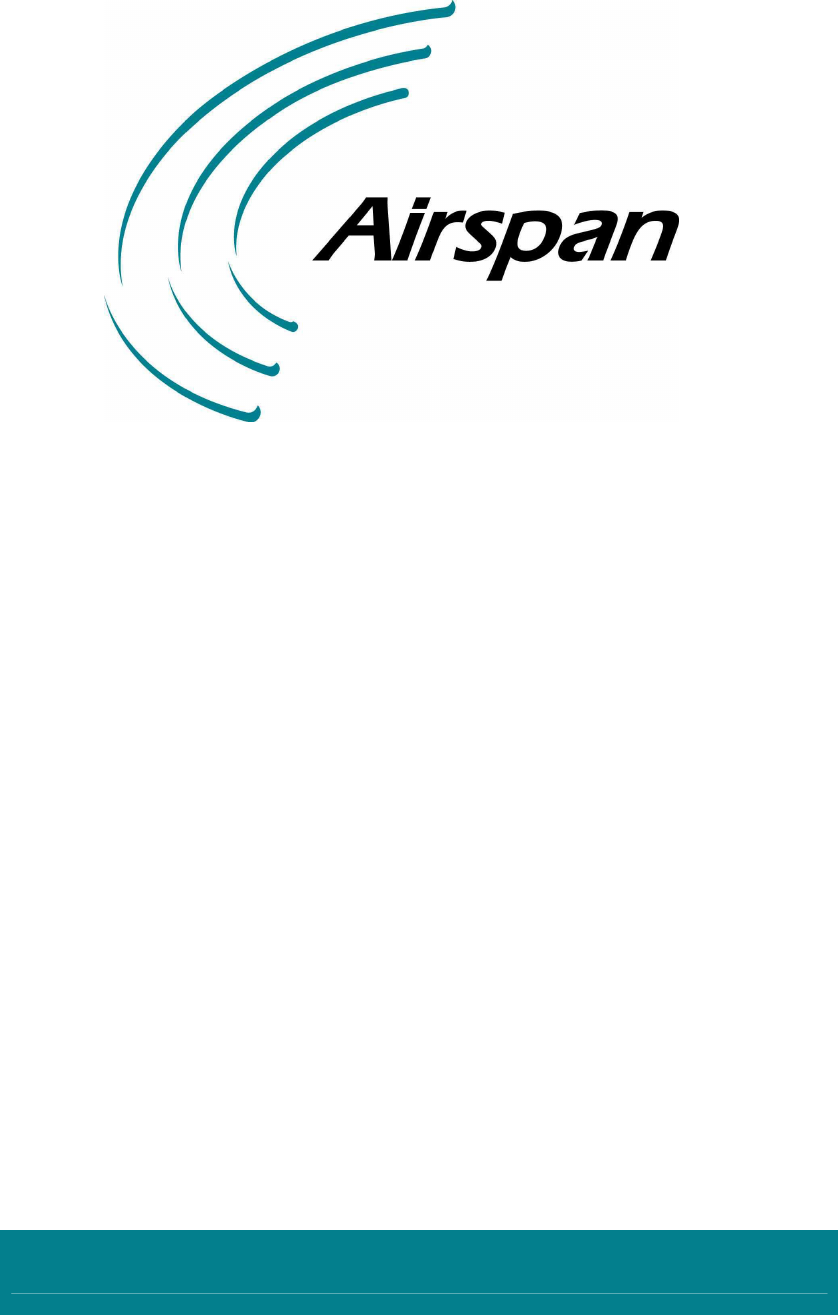
Leading the World in Wireless DSL
ASWipLL and
ASWipLL and ASWipLL and
ASWipLL and
AS3010 Systems
AS3010 SystemsAS3010 Systems
AS3010 Systems
Wireless IP-Based Local Loop System
Release 4.6
Hardware Installation
Guide
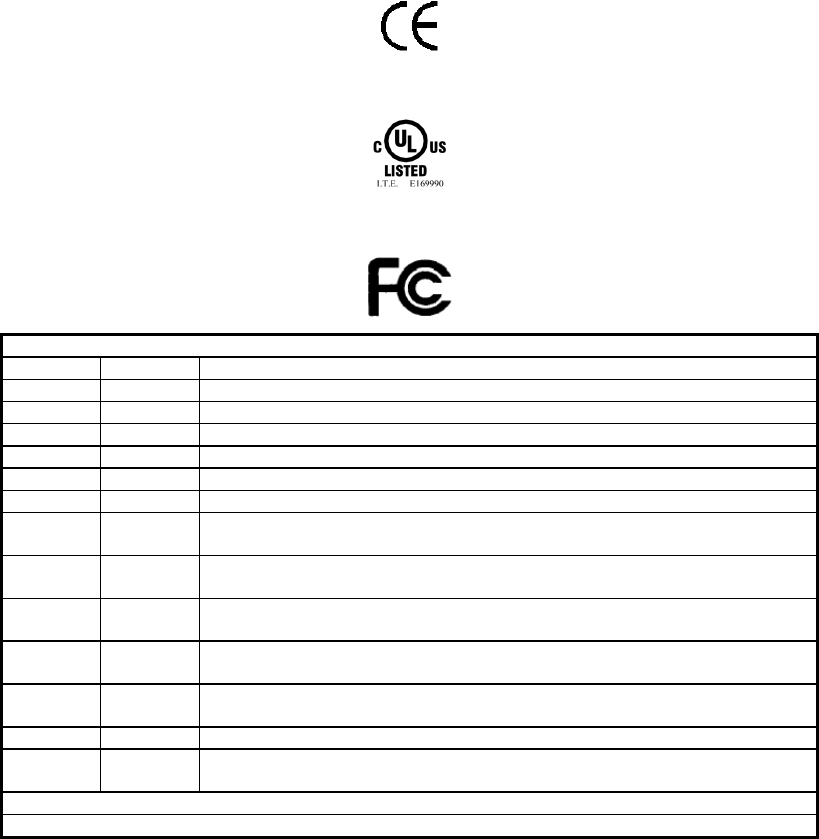
The ASWipLL product bears the CE marking. This CE marking demonstrates ASWipLL's full compliance with
applicable European Union (EU) directives:
The ASWipLL product bears the Underwriters Laboratories (UL) marking, demonstrating full compliance with UL's
safety requirements:
ASWipLL products also bear the Federal Communications Commission (FCC) marking, demonstrating compliance
with FCC Part 15 regulations.
Revision Record: ASWipLL Hardware Installation Guide
Pub. Rev. Date Update Description
- Nov-00 First edition and printing. (Marconi)
- Mar-01 ASWipLL Release 1.4 (Marconi)
- Apr-01 ASWipLL Release 2.0 (Marconi)
- Jul-01 ASWipLL Release 2.2 (Marconi)
- Nov-01 ASWipLL Release 2.6 (Marconi)
- Jun-02 ASWipLL Release 3.0A (Marconi)
01 Feb-03 ASWipLL Release 4.0. Author: MD. Updates: Airspan template and content
(connector pinouts; cable crimping, and general)
02 May-03 ASWipLL Release 4.2F. Author: MD. Updates: graphics, deleted BSR with serial
port.
03 Jul-03 ASWipLL Release 4.2A. Author: MD. Updates: Chapter 1 for Transparent
Bridging; 5.8 GHz; 2.8 GHz.
04 Aug-03 ASWipLL Release 4.2A. Author: MD. Updates: formatting; graphics; BSDU
LEDs
05 Oct-03 ASWipLL & AS3010 Rel. 42B. Auth: MD. Updates: RSSI Plug for SPR; IDR
RSSI levels; SDA-4S/Vltag; safety guidelines; Append. D.
06 Feb-04 ASWipLL & AS3010 Rel. 4.4. Auth: MD. Updates: RSS LED plug photo
07 Aug-04 Rel. 4.6. Auth: MD. Updates: SDA-1/48V; SDA-1/DC; Link Quality; additional
FCC safety guidelines; Site Planning; miscellaneous.
Publication No. 02030311-07

Copyright by Airspan Networks LTD., 2003. All rights reserved worldwide.
The information contained in this document is proprietary and is subject to all relevant copyright, patent and other
laws protecting intellectual property, as well as any specific agreement protecting Airspan Networks LTD. rights in
the aforesaid information. Neither this document nor the information contained herein may be published,
reproduced or disclosed to third parties, in whole or in part, without the express, prior, written permission of
Airspan Networks LTD. In addition, any use of this document or the information contained herein for any purposes
other than those for which it was disclosed is strictly forbidden.
Airspan Networks LTD. reserves the right, without prior notice or liability, to make changes in equipment design or
specifications.
Information supplied by Airspan Networks LTD. is believed to be accurate and reliable. However, no responsibility
is assumed by Airspan Networks LTD. for the use thereof nor for the rights of third parties which may be effected
in any way by the use thereof.
Any representation(s) in this document concerning performance of Airspan Networks LTD. product(s) are for
informational purposes only and are not warranties of future performance, either express or implied. Airspan
Networks LTD. standard limited warranty, stated in its sales contract or order confirmation form, is the only
warranty offered by Airspan Networks LTD. in relation thereto.
This document may contain flaws, omissions or typesetting errors; no warranty is granted nor liability assumed in
relation thereto unless specifically undertaken in Airspan Networks LTD. sales contract or order confirmation.
Information contained herein is periodically updated and changes will be incorporated into subsequent editions. If
you have encountered an error, please notify Airspan Networks LTD. All specifications are subject to change
without prior notice.
Main Operations:
Airspan Communications Ltd.
Cambridge House
Oxford Road
Uxbridge
Middlesex
UB8 1UN
United Kingdom
Tel: (44)-895 467100
Web site: http//www.airspan.com
Customer Service (TAC): Wipll.tech_support@airspan.com
This page is intentionally left blank.

Hardware Installation Guide Contents
02030311-07 Airspan Networks Inc. v
Contents
About this Guide ................................................................................................. xv
Purpose......................................................................................................xv
Referenced Documentation ........................................................................xv
Targeted Audience .................................................................................... xvi
Organization of this Guide ......................................................................... xvi
Conventions .............................................................................................xviii
Customer Service .....................................................................................xviii
1. Overview ................................................................................................. 1-1
1.1. Introduction........................................................................................ 1-1
1.2. System Architecture........................................................................... 1-2
1.3. Base Station Units ............................................................................. 1-4
1.3.1. Base Station Radio (BSR) ................................................... 1-5
1.3.2. Point-to-Point Radio (PPR).................................................. 1-5
1.3.3. Base Station Distribution Unit (BSDU)................................. 1-6
1.3.4. SDA-1/48V .......................................................................... 1-6
1.3.5. Global Positioning System (GPS) - Optional........................ 1-6
1.3.6. Base Station Power Supply (BSPS) - Optional .................... 1-7
1.4. Subscriber Site Units ......................................................................... 1-8
1.4.1. Outdoor Radio (SPR) with Indoor Switch/Hub (SDA)........... 1-8
1.4.1.1. Subscriber Premises Radio (SPR) ........................ 1-8
1.4.1.2. Subscriber Data Adapter (SDA) ............................ 1-9
1.4.2. Indoor Radio Unit (IDR) Only............................................. 1-12

Contents Hardware Installation Guide
vi Airspan Networks Inc. 02030311-07
2. Safety Guidelines ..................................................................................... 2-1
2.1. ASWipLL Radios and Third-Party External Antennas ......................... 2-2
2.2. Electrical Safety Guidelines................................................................. 2-5
2.2.1. Handling Electrostatic Devices ............................................. 2-5
2.2.2. Grounding............................................................................. 2-6
2.2.3. Lightening Protection............................................................ 2-6
2.3. Cabling ................................................................................................ 2-7
2.3.1. Considerations...................................................................... 2-7
2.3.2. Labeling ................................................................................ 2-9
2.3.2.1. Voltage Warning .................................................... 2-9
2.3.2.2. High Earth Leakage Current ................................ 2-10
2.3.2.3. Signal Cable Designation..................................... 2-10
3. Package Contents .................................................................................... 3-1
3.1. Base Station Equipment...................................................................... 3-1
3.1.1. BSR ...................................................................................... 3-2
3.1.2. BSDU.................................................................................... 3-3
3.1.3. SDA-1/48V............................................................................ 3-4
3.1.4. BSPS .................................................................................... 3-4
3.1.5. GPS ...................................................................................... 3-5
3.2. Customer Premises Equipment........................................................... 3-5
3.2.1. SPR ...................................................................................... 3-6
3.2.2. RSSI LED Adapter................................................................ 3-6
3.2.3. SDA-1, SDA-4H and SDA-4S Models .................................. 3-7
3.2.4. SDA-1/DC............................................................................. 3-7
3.2.5. IDR ....................................................................................... 3-8
4. Required Tools ......................................................................................... 4-1

Hardware Installation Guide Contents
02030311-07 Airspan Networks Inc. vii
5. Radio Site Planning.................................................................................. 5-1
5.1. Minimal Radio Path Obstructions........................................................ 5-2
5.2. Fresnel Zone Clearance...................................................................... 5-2
5.3. Multipath Fading.................................................................................. 5-3
5.4. Spectrum Analysis for Locating Clear Frequencies ............................ 5-4
5.5. Adjacent Base Station Radios............................................................. 5-4
5.6. Radio Antenna Alignment.................................................................... 5-4
5.7. Considerations when Using External Antennas .................................. 5-5
5.7.1. Cable Loss............................................................................ 5-5
5.7.2. Omni-Directional Antennas................................................... 5-7
5.7.3. Operating in Band-C for FCC Markets ................................. 5-8
Part I: Base Station Installation
6. Basic Design of Devices.......................................................................... 6-1
6.1. BSR..................................................................................................... 6-1
6.1.1. Physical Dimensions ............................................................ 6-1
6.1.2. Ports ..................................................................................... 6-2
6.2. BSDU .................................................................................................. 6-3
6.2.1. Physical Dimensions ............................................................ 6-3
6.2.2. Ports ..................................................................................... 6-3
6.2.3. LED Indicators ...................................................................... 6-4
6.2.3.1. BSR’s LEDs ........................................................... 6-5
6.2.3.2. 100Base-T LEDs.................................................... 6-5
6.2.3.3. Status LEDs ........................................................... 6-6
6.3. SDA-1/48V .......................................................................................... 6-6
6.3.1. Physical Dimensions ............................................................ 6-6
6.3.2. Ports ..................................................................................... 6-7
6.3.3. LED Indicators ...................................................................... 6-8

Contents Hardware Installation Guide
viii Airspan Networks Inc. 02030311-07
6.4. GPS..................................................................................................... 6-9
6.4.1. Ports ..................................................................................... 6-9
6.4.2. Physical Dimensions ............................................................ 6-9
6.5. BSPS................................................................................................. 6-10
7. Mounting the Devices .............................................................................. 7-1
7.1. Pole-Mounting the BSR....................................................................... 7-1
7.2. Rack Mounting the BSDU ................................................................... 7-9
7.3. Mounting the SDA-1/48V................................................................... 7-10
7.4. Mounting the BSPS (Optional) .......................................................... 7-11
8. Network Cabling ....................................................................................... 8-1
8.1. BSR Connected to an SDA ................................................................. 8-2
8.1.1. Connecting BSR to SDA....................................................... 8-2
8.1.2. Connecting SDA to Provider's Ethernet Network ................. 8-5
8.2. BSR Connected to a BSDU................................................................. 8-5
8.2.1. Connecting BSR to BSDU .................................................... 8-5
8.2.2. Connecting BSDU to 100BaseT Networks ........................... 8-8
8.2.3. Daisy-Chaining BSDUs ...................................................... 8-10
8.2.4. Connecting BSDU Synchronization Ports .......................... 8-12
8.2.5. Connecting BSDU to PC for SNMP Management.............. 8-15
8.3. BSR Connected to SDA-1/48V.......................................................... 8-18
8.3.1. Connecting BSR to SDA-1/48V .......................................... 8-18
8.3.2. Connecting SDA-1/48V to 10BaseT Network..................... 8-21
9. Serial Cabling ........................................................................................... 9-1
9.1. Serial Cabling BSR to a PC................................................................. 9-2
9.2. Serial Cabling BSDU to a PC .............................................................. 9-4
9.3. Serial Cabling BSPS to a BSDU ......................................................... 9-6

Hardware Installation Guide Contents
02030311-07 Airspan Networks Inc. ix
10. Connecting Third-Party External Antennas......................................... 10-1
10.1. Connecting Radio Antennas to BSR ............................................... 10-1
10.2. Connecting GPS Antenna to BSDU ................................................ 10-4
10.2.1. Mounting the GPS ............................................................ 10-4
10.2.2. Connecting the GPS......................................................... 10-5
11. Power Cabling ........................................................................................ 11-1
11.1. Connecting Power to BSDU ............................................................ 11-2
11.1.1. Grounding the BSDU........................................................ 11-2
11.1.2. Connecting Power Source (e.g. BSPS) to BSDU............. 11-3
11.2. Connecting Power to SDA-1/48 ...................................................... 11-6
11.3. Connecting Power to SDA............................................................... 11-8
Part II: CPE Installation - SPR
12. Basic Design of Devices........................................................................ 12-1
12.1. SPR................................................................................................. 12-2
12.1.1. Physical Dimensions ........................................................ 12-2
12.1.2. Ports ................................................................................. 12-3
12.2. SDA................................................................................................. 12-4
12.2.1. Physical Dimensions ........................................................ 12-4
12.2.2. Ports ................................................................................. 12-4
12.2.3. LED Indicators .................................................................. 12-8
12.2.3.1. SDA-4S .............................................................. 12-8
12.2.3.2. SDA-4H............................................................ 12-10
12.2.3.3. SDA-1 .............................................................. 12-11
12.3. RSS LED Adapter ......................................................................... 12-12
12.3.1. Physical Dimensions ...................................................... 12-12
12.3.2. Ports ............................................................................... 12-13
12.3.3. LEDs............................................................................... 12-14

Contents Hardware Installation Guide
x Airspan Networks Inc. 02030311-07
13. Mounting the Devices ............................................................................ 13-1
13.1. Wall Mounting the SPR ................................................................... 13-1
13.2. Mounting the SDA ........................................................................... 13-8
13.2.1. Desktop Mounting............................................................. 13-8
13.2.2. Wall Mounting................................................................... 13-9
14. Network Cabling..................................................................................... 14-1
14.1. Connecting SPR to SDA ................................................................. 14-2
14.2. Connecting SDA to Subscriber’s Ethernet Network ........................ 14-5
14.2.1. Connecting to a LAN/PC .................................................. 14-5
14.2.2. Connecting to a Hub......................................................... 14-8
14.2.3. Connecting to a VoIP Network (RGW) ........................... 14-11
15. Serial Cabling ......................................................................................... 15-1
16. Connecting Third-Party External Antennas......................................... 16-1
17. Antenna Alignment using RSS LED Adapter....................................... 17-1
18. Power Cabling ........................................................................................ 18-1
18.1. SPR Connected to SDA-1/DC......................................................... 18-2
18.1.1. Housing the Power Connectors........................................ 18-3
18.1.2. Connecting Power Connector to SDA-1/DC..................... 18-4
18.2. SPR Connected to SDA-1, SDA-4H, or SDA-4S............................. 18-5

Hardware Installation Guide Contents
02030311-07 Airspan Networks Inc. xi
Part III: CPE Installation - IDR
19. Basic Design........................................................................................... 19-1
19.1. Physical Dimensions ....................................................................... 19-1
19.2. Ports................................................................................................ 19-2
19.3. LED Indicators................................................................................. 19-3
20. Mounting ................................................................................................. 20-1
20.1. Attaching the Front Cover ............................................................... 20-2
20.2. Desktop Mounting ........................................................................... 20-4
20.2.1. Vertical Desktop Mounting................................................ 20-4
20.2.2. Horizontal-Desktop Mounting ........................................... 20-6
20.3. Wall and Pole Mounting .................................................................. 20-7
20.3.1. Wall Mounting................................................................... 20-7
20.3.2. Pole Mounting................................................................. 20-10
21. Network Cabling..................................................................................... 21-1
22. Serial Cabling ......................................................................................... 22-1
23. Connecting Third-Party External Antenna........................................... 23-1
24. Antenna Alignment Using RSS LEDs................................................... 24-1
25. Power Cabling ........................................................................................ 25-1
A. Glossary....................................................................................................A-1
B. Installing the BSPS ..................................................................................B-1
B.1. Basic Design.......................................................................................B-2
B.2. Physical Dimensions...........................................................................B-5
B.3. Electrical Site Requirements...............................................................B-5

Contents Hardware Installation Guide
xii Airspan Networks Inc. 02030311-07
B.4. BSPS Cabinet Cabling........................................................................B-6
B.5. Installation Summary .......................................................................... B-8
B.6. BSPS Batteries .................................................................................B-10
B.6.1. Installing .............................................................................B-10
B.6.2. Determining Battery Size ...................................................B-13
B.7. Rectifiers...........................................................................................B-14
B.7.1. Installing .............................................................................B-14
B.7.2. Calibrating ..........................................................................B-15
B.8. Operating the System Controller....................................................... B-16
B.9. Powering on BSPS ........................................................................... B-18
B.10. Connecting BSPS Management Cables ......................................... B-19
B.11. Cabinet Power Requirements ......................................................... B-19
B.11.1. Cabinet Grounding ...........................................................B-22
B.11.2. Equipment Supplementary Grounding ............................. B-22
B.12. Troubleshooting .............................................................................. B-23
C. Cable Crimping.........................................................................................C-1
C.1. IDC Crimping of CAT 5 Cables to 15-pin D-Type Connectors............C-2
C.1.1. CAT 5 Wire Color-Coding ....................................................C-4
C.1.2. Crimping...............................................................................C-5
C.1.3. Inspecting the Crimped Connector ......................................C-7
C.1.4. Assembling the Connector Hood .........................................C-7
C.1.4.1. Outdoor Units ........................................................C-8
C.1.4.2. Indoor Units .........................................................C-10
C.2. Crimping N-type Connectors ............................................................C-13
C.2.1. Stripping the Cable ............................................................C-13
C.2.2. Assembling the Connector.................................................C-14
C.2.3. Crimping.............................................................................C-16
C.3. Crimping GPS Cable Connectors .....................................................C-17

Hardware Installation Guide Contents
02030311-07 Airspan Networks Inc. xiii
D. Connector Pinouts for SPR with DB9 Port ............................................D-1
E. Evaluating Link Quality............................................................................E-1
E.1. RSSI Levels ........................................................................................E-2
E.1.1. Measuring RSSI at SPR using WipConfig ...........................E-3
E.1.2. Measuring RSSI at BSR using WipManage.........................E-4
E.2. Carrier-to-Interference Ratio............................................................... E-5
E.2.1. Spectrum Analysis using WipConfig ....................................E-6
E.2.1.1. Accessing the Spectrum Analyzer.........................E-6
E.2.1.2. Setting up the Spectrum Analyzer .........................E-7
E.2.1.3. Starting the Spectrum Analyzer.............................E-8
E.2.1.4. Viewing Results ..................................................... E-8
E.3. Bit Error Rate (BER) ........................................................................... E-9
E.3.1. Measuring BER Using WipConfig ......................................E-10
E.3.2. Measuring BER Using WipManage.................................... E-11
E.4. Generating Traffic to Measure Throughput.......................................E-12
F. Technical Specifications ......................................................................... F-1
F.1. Base Station Equipment...................................................................... F-2
F.1.1. Base Station Radio (BSR).................................................... F-2
F.1.2. Point-to-Point Radio (PPR) .................................................. F-6
F.1.3. Base Station Distribution Unit (BSDU) ................................. F-7
F.1.4. SDA-1/48V ........................................................................... F-8
F.1.5. Base Station Power Supply (BSPS)..................................... F-9
F.1.6. GPS Antenna ..................................................................... F-12

Contents Hardware Installation Guide
xiv Airspan Networks Inc. 02030311-07
F.2. Customer Premises ASWipLL Equipment ........................................ F-13
F.2.1. Subscriber Premises Radio (SPR) ..................................... F-13
F.2.2. Subscriber Data Adapter (SDA) ......................................... F-17
F.2.2.1. SDA-1 .................................................................. F-17
F.2.2.2. SDA-4H................................................................ F-18
F.2.2.3. SDA-4S Models ................................................... F-19
F.2.2.4. SDA-1/DC ............................................................ F-20
F.2.3. Indoor Data Radio (IDR)..................................................... F-21
G. Third-Party External Antenna Specifications ........................................G-1
G.1. ASWipLL 900 .....................................................................................G-1
G.1.1. BSR (at Base Station)..........................................................G-1
G.1.1.1. Panel 35°/ 18.6 dBi ...............................................G-2
G.1.1.2. Panel 120°/16 dBi .................................................G-4
G.1.1.3. Panel 62°/16 dBi ...................................................G-5
G.1.1.4. Panel 90°/17 dBi ...................................................G-7
G.1.1.5. Omni-Directional 360°/12 dBi (3° Lobe Tilt) ..........G-9
G.1.1.6. Omni-Directional 360°/12 dBi (5° Lobe Tilt) ........G-11
G.1.1.7. Sector Antenna (65°/15.5 dBi) ............................G-13
G.1.1.8. Omni-Directional Antenna (11 dBi) .....................G-15
G.1.2. IDR (at Subscriber Site).....................................................G-16
G.1.2.1. 10 dBi Panel........................................................G-17
G.1.2.2. 6.5 dBi Panel.......................................................G-18
G.2. ASWipLL 700 ...................................................................................G-20
G.2.1. Antenna Specifications ......................................................G-20
G.2.2. RF Planning Guidelines for Band C in FCC Markets.........G-22
H. Declaration of Conformity .......................................................................H-1
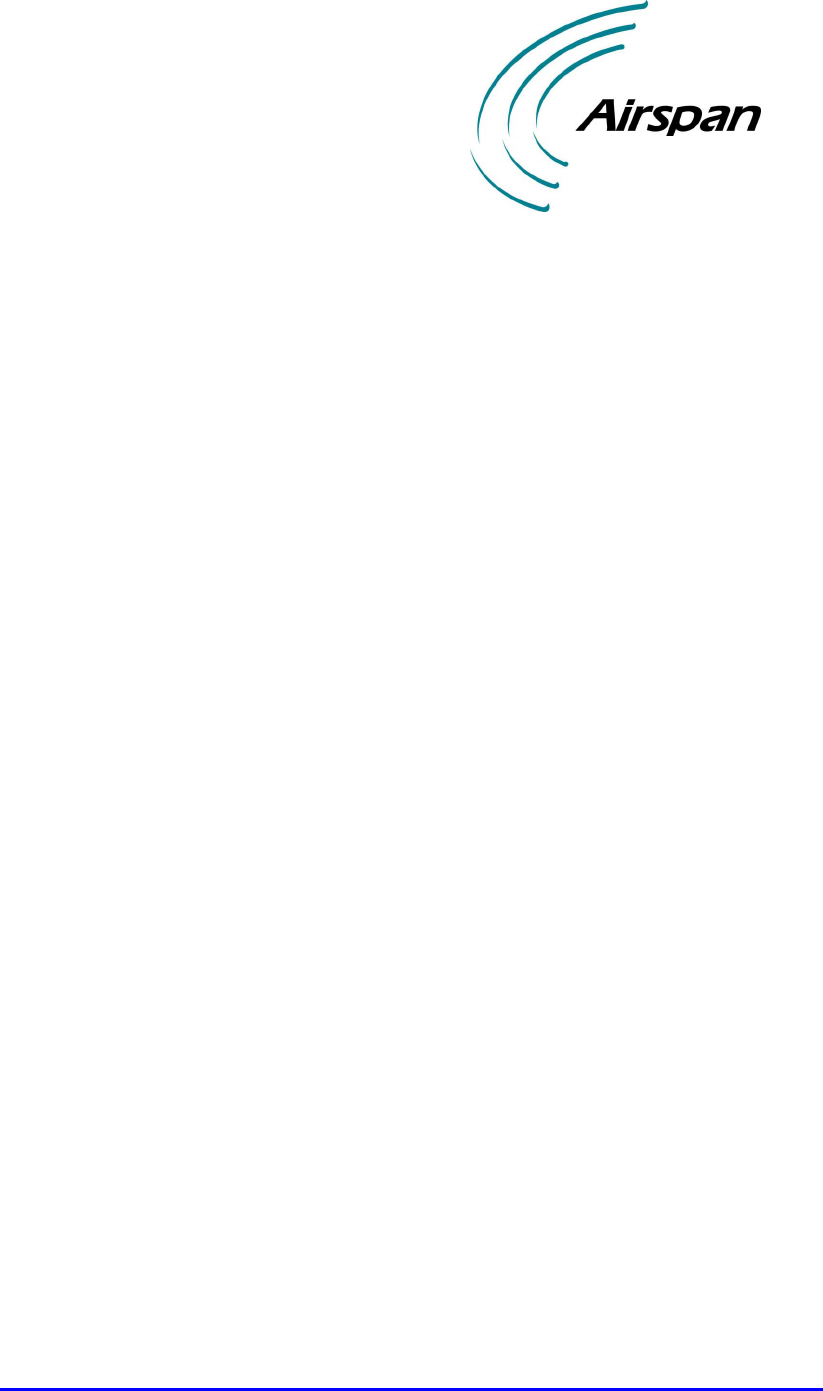
02030311-07 Airspan Networks Inc. xv
About this Guide
About this GuideAbout this Guide
About this Guide
This section discusses the purpose, targeted audience, references, organization, and
technical support of the ASWipLL Hardware Installation Guide.
Purpose
This guide describes the procedures for installing Airspan’s ASWipLL devices.
These devices include the Base Station Radio (BSR), Base Station Distribution Unit
(BSDU), Base Station Power Supply (BSPS), Global Positioning System antenna
(GPS), Subscriber Premises Radio (SPR), Subscriber Data Adapter (SDA), and
Indoor Data Radio (IDR).
Referenced Documentation
Although this guide provides software configuration information for certain
ASWipLL devices, it is not comprehensive. For detailed software configuration, see
the, , and The following documentation is referenced in this guide:
! ASWipLL System Description: provides an overview of the entire ASWipLL
system.
! WipConfig User's Guide: Airspan recommends that you refer to this manual for
performing serial initial configuration.
! WipManage User's Guide: Airspan recommends that you refer to this guide for
descriptions on managing the ASWipLL devices.
! ASWipLL Commissioning Manual: Airspan recommends that you refer to this
guide for descriptions on managing the ASWipLL devices.

About this Guide Hardware Installation Guide
xvi Airspan Networks Inc. 02030311-07
Targeted Audience
This guide is intended for the person who is responsible for installing the ASWipLL
system. This person should be familiar with electronic circuitry and wiring.
Organization of this Guide
This guide is organized into the following chapters and parts:
! Chapter 1, "Overview": provides a brief overview of the ASWipLL devices.
! Chapter 2, "Safety Guidelines": lists the safety guidelines for handling cables
and electricity during the installation.
! Chapter 3, "Package Contents": lists items provided in standard ASWipLL kits.
! Chapter 4, "Required Tools": lists the tools required for installing the system.
! Chapter 5, "Radio Site Planning": describes radio issues for planning the site
before installation.
! Part 1, "Base Station Installation": includes the following chapters concerned
with installing ASWipLL equipment at the Base Station:
! Chapter 6, "Basic Design of Devices"
! Chapter 7, "Mounting the Devices"
! Chapter 8, "Network Cabling"
! Chapter 9, "Serial Cabling"
! Chapter 10, "Connecting Third-Party External Antennas"
! Chapter 11, "Power Cabling"
! Part 2, "CPE Installation - SPR": includes the following chapters concerned
with installing an SPR (interfacing with subscriber's network through an SDA) at
the subscriber’s premises:
! Chapter 12, "Basic Design of Devices"

Hardware Installation Guide About this Guide
02030311-07 Airspan Networks Inc. xvii
! Chapter 13, "Mounting the Devices"
! Chapter 14, "Network Cabling"
! Chapter 15, "Serial Cabling"
! Chapter 16, "Connecting Third-Party External Antennas"
! Chapter 17, "Antenna Alignment using RSS LED Adapter"
! Chapter 18, "Power Cabling"
! Part 3, "CPE Installation - IDR": includes the following chapters concerned
with installing an IDR at the subscriber’s premises:
! Chapter 19, "Basic Design"
! Chapter 20, "Mounting"
! Chapter 21, "Network Cabling"
! Chapter 22, "Serial Cabling"
! Chapter 23, "Connecting Third-Party External Antenna"
! Chapter 24, "Antenna Alignment using RSS LEDs"
! Chapter 25, "Power Cabling"
! Appendix A, "Glossary": glossary of terms used in this guide
! Appendix B, "Installing the BSPS": describes the procedures for installing an
optional third-party Base Station Power System.
! Appendix C, "Cable Crimping": describes the crimping procedure for 15-Pin
D-type, N-type, and GPS connectors.
! Appendix D, "Connector Pinouts for SPR with DB9 Port": describes
connector pinouts for SPR-to-RSS LED Adapter cabling when the old SPR
model that provides a 9-pin D-type port is used.
! Appendix E, "Evaluating Link Quality": describes the procedures for
evaluating quality of the BSR-SPR link.
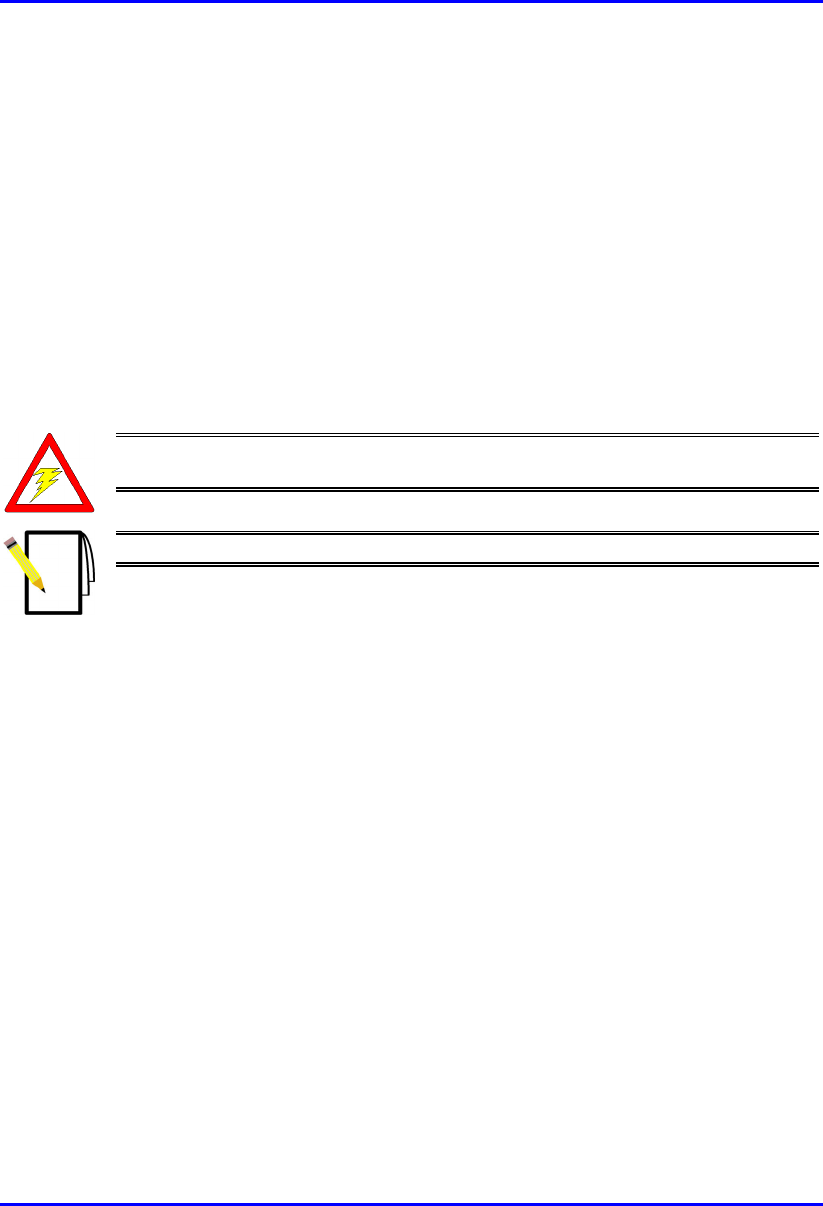
About this Guide Hardware Installation Guide
xviii Airspan Networks Inc. 02030311-07
Appendix F, "Technical Specification": lists the technical specifications of the
ASWipLL devices.
Appendix G, "Third-Party External Antenna Specifications": lists the
technical specifications of third-party external antennas.
Appendix H, "FCC Declaration of Conformity for IDR": provides a
declaration of FCC conformity for the IDR.
Conventions
This guide uses the following bulletin conventions:
Warning: Provides information that can prevent and avoid bodily o
r
mechanical harm.
Note: Provides useful information.
Customer Service
For service and support for your ASWipLL system, contact your regional Airspan
representative, or Airspan’s Technical Assistance Center (TAC) at:
E-mail: WipLL.tech_support@Airspan.com
Boca Raton Call Center: (+1) 561 893-8679
UK Call Centre: (+44) 1895 467 467
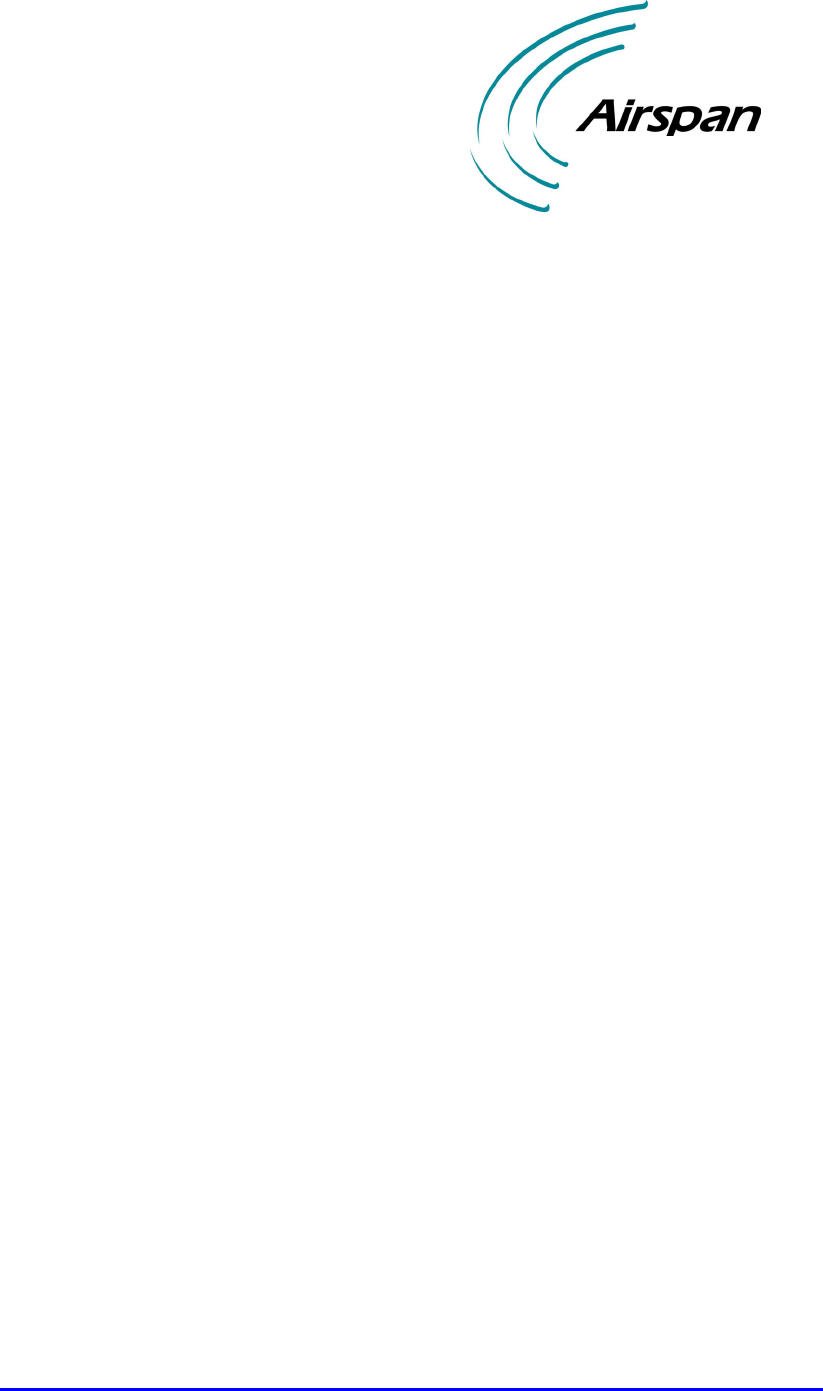
02030311-07 Airspan Networks Inc. 1-1
Overview
This chapter provides a brief overview of the ASWipLL system.
1.1. Introduction
Airspan’s ASWipLL system provides a low-cost, high-performance point-to-
multipoint IP-based Broadband Fixed Wireless (BFW) Access solution. ASWipLL
provides wireless local-loop (last-mile) connectivity designed to deliver high-speed
data, Voice over IP (VoIP), and multimedia services to residential, SOHO (small
office/home office), and SME (small medium enterprise). ASWipLL offers service
providers an integrated access solution, providing quick-to-market deployment and
low-market entry cost for broadband services.
ASWipLL operates in the licensed band (700 MHz, 925 MHz, 1.5 GHz, 2.3 GHz,
2.5 GHz Multichannel Multipoint Distribution Services - MMDS, 2.8 GHz, and 3.x
GHz - ranging from 3.3 to 3.8 GHz), and unlicensed band (900 MHz, 2.4 GHz ISM,
and 5.8 GHz).
Each ASWipLL Base Station, at maximum configuration, supports up to 3,024
subscribers, providing connectivity speeds of up to 4 Mbps.
ASWipLL enables interconnection with the Public Switched Telephone Network
(PSTN) by the use of an IP-to-PSTN gateway. ASWipLL provides VoIP by its
interoperability with a wide range of third-party products such as residential
gateways (RGW), access gateways, gatekeepers, and softswitches.
1

Overview Hardware Installation Guide
1-2 Airspan Networks Inc. 02030311-07
ASWipLL utilizes air protocol technology for wireless packet switching using
Frequency Hopping technology. ASWipLL's in-house Preemptive Polling Multiple
Access (PPMA) Air MAC protocol technology, which recognizes transmission type
and allocates bandwidth, is highly efficient—80% throughput (e.g. 80% of 4 Mbps =
3.2 Mbps net capacity)—allowing multiple concurrent subscribers to utilize
bandwidth.
ASWipLL provides bandwidth management by supporting both asymmetric and
aggregated Committed Information Rate (CIR) and Maximum Information Rate
(MIR), guaranteeing bandwidth levels to subscribers. In asymmetric CIR/MIR,
different values are defined for uplink and downlink traffic: in aggregated CIR/MIR,
values are defined as the sum of the uplink and downlink traffic.
ASWipLL supports VLANs and VPNs based on IEEE 802.1Q/p. ASWipLL
supports IP routing and PPPoE bridging, as well as transparent bridging.
ASWipLL provides embedded security features such as IP (packet) filtering based
on addresses, protocols, and applications.
The ASWipLL system provides SNMP-based management, allowing remote and
local management, configuration, and monitoring of ASWipLL equipment.
1.2. System Architecture
The ASWipLL system architecture is composed of the following three basic areas:
Base Station site: consists of ASWipLL access units that interface between the
provider’s backbone and the ASWipLL subscriber sites.
Subscriber site: consists of ASWipLL customer premises equipment (CPE) that
interfaces between the Base Station and the subscriber’s network.
Network management tools: consists mainly of Windows- and SNMP-based
programs, providing fault, configuration, performance, and security management
for the ASWipLL system.
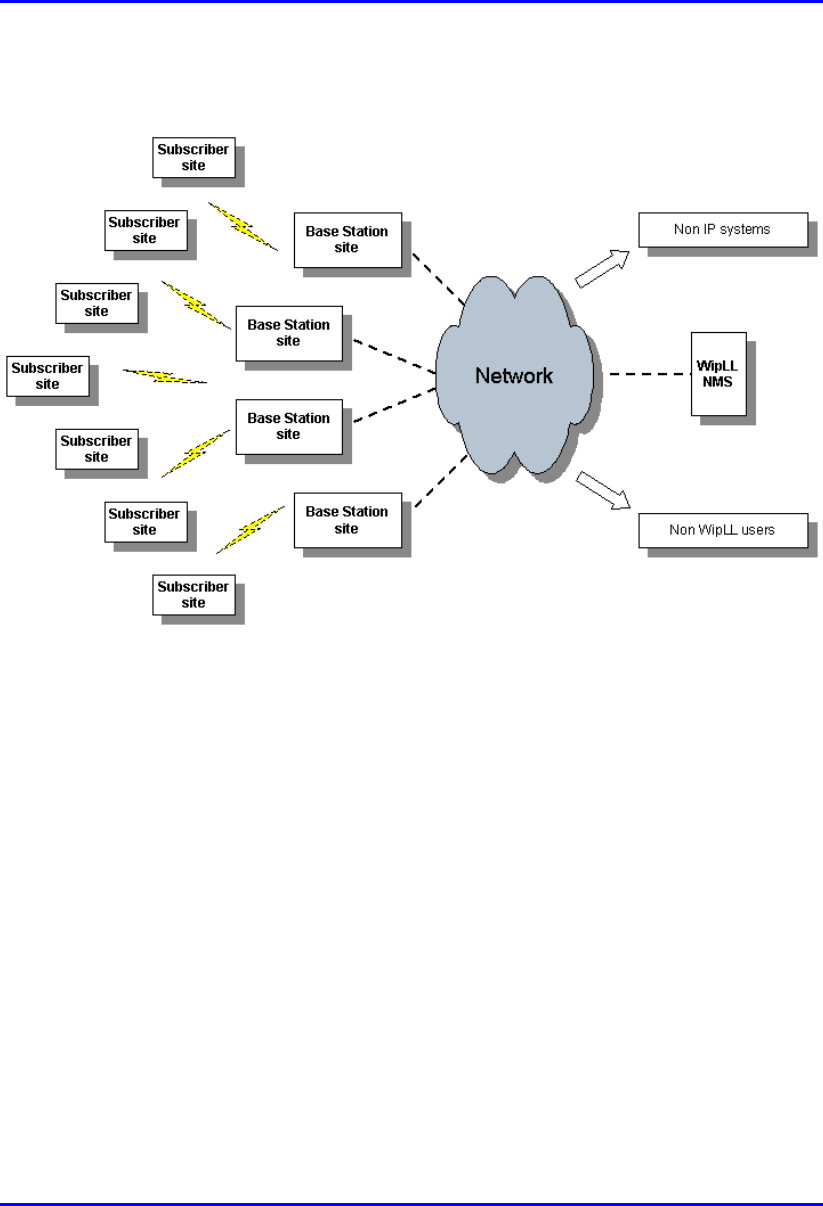
Hardware Installation Guide Overview
02030311-07 Airspan Networks Inc. 1-3
Figure 1-1 displays a block diagram of the main areas of the ASWipLL system.
Figure 1-1: ASWipLL System Architecture
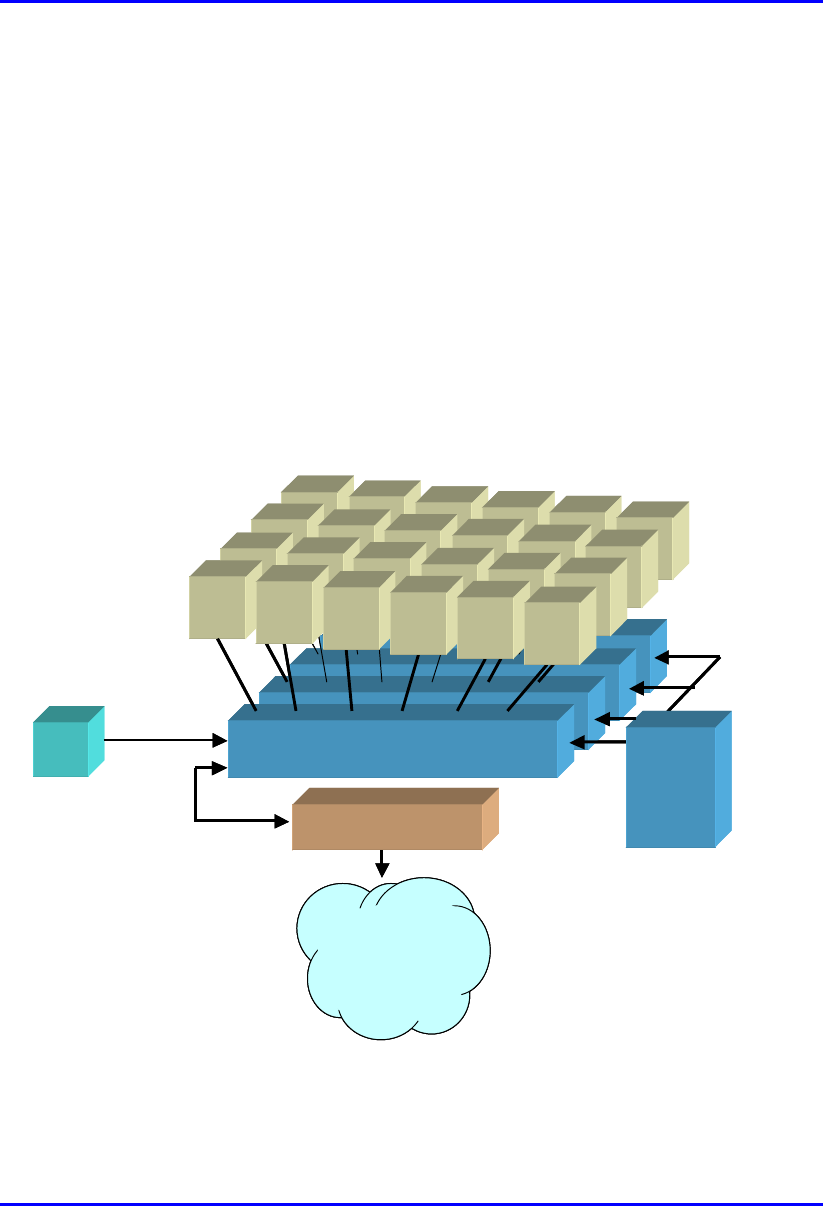
Overview Hardware Installation Guide
1-4 Airspan Networks Inc. 02030311-07
1.3. Base Station Units
The ASWipLL Base Station interfaces between the subscriber sites and the service
provider's backbone, providing subscribers with high-speed data, Internet, and VoIP
services.
The ASWipLL system provides various devices (some optional) for the Base Station
site. The implementation of these devices depends on the desired network (e.g.
point-to-point radio link), number of outdoor radios and power source at the Base
Station, and required synchronization type (i.e. by GPS).
Figure 1-2 shows a fully populated ASWipLL Base Station at maximum
configuration (24 BSRs, 4 BSDUs, 1 BSPS, and a GPS).
BSR
BSDU
BSR BSR BSR BSR BSR
BSR
BSDU
BSR BSR BSR BSR BSR
BSR
BSDU
BSR BSR BSR BSR BSR
BSR
BSRBSR
BSR
BSDU
BSDUBSDU
BSDU
-
--
-48
4848
48 VDC
VDCVDC
VDC
100
100100
100B
BB
BaseT
aseTaseT
aseT
BSPS
BSPSBSPS
BSPS
BSR
BSRBSR
BSR BSR
BSRBSR
BSR BSR
BSRBSR
BSR BS
SS
SRBSR
BSRBSR
BSR
GPS
GPSGPS
GPS
Backbone
BackboneBackbone
Backbone
(
((
(IP, ATM,FR, MPLS
IP, ATM,FR, MPLSIP, ATM,FR, MPLS
IP, ATM,FR, MPLS)
))
)
Interface unit
Interface unit Interface unit
Interface unit
(
((
(e
ee
e.
..
.g
gg
g.
. .
. router, switch
router, switchrouter, switch
router, switch)
))
)
BSR
BSDU
BSR BSR BSR BSR BSR
BSR
BSDU
BSR BSR BSR BSR BSR
BSR
BSDU
BSR BSR BSR BSR BSR
BSR
BSRBSR
BSR
BSDU
BSDUBSDU
BSDU
-
--
-48
4848
48 VDC
VDCVDC
VDC
100
100100
100B
BB
BaseT
aseTaseT
aseT
BSPS
BSPSBSPS
BSPS
BSR
BSRBSR
BSR BSR
BSRBSR
BSR BSR
BSRBSR
BSR BS
SS
SRBSR
BSRBSR
BSR
GPS
GPSGPS
GPS
Backbone
BackboneBackbone
Backbone
(
((
(IP, ATM,FR, MPLS
IP, ATM,FR, MPLSIP, ATM,FR, MPLS
IP, ATM,FR, MPLS)
))
)
Interface unit
Interface unit Interface unit
Interface unit
(
((
(e
ee
e.
..
.g
gg
g.
. .
. router, switch
router, switchrouter, switch
router, switch)
))
)
Figure 1-2: ASWipLL Base Station units (maximum configuration)

Hardware Installation Guide Overview
02030311-07 Airspan Networks Inc. 1-5
1.3.1. Base Station Radio (BSR)
The BSR is an outdoor radio unit, typically mounted on a pole or wall, involved in
providing a wireless link between the Base Station and subscribers. The standard
BSR provides 60-degree radio coverage, serving up to 126 subscribers in a sector.
The BSR is available in the following models:
! BSR with a built-in antenna
! BSR with one N-type port for connecting an optional third-party external
antenna
! BSR with two N-type ports for connecting two optional third-party external
antennas for dual antenna diversity
For Base Stations consisting of multiple BSRs, the BSRs are powered, and interface
with the provider’s backbone by the ASWipLL Base Station Distribution Unit
(BSDU). For a Base Station consisting of a single BSR, the BSR is typically
powered and connected to the provider’s backbone by the ASWipLL Subscriber
Data Adapter (SDA).
1.3.2. Point-to-Point Radio (PPR)
The PPR device is similar to the BSR, but implemented in a point-to-point radio
configuration, providing wireless communication with a single remote subscriber
ASWipLL radio unit (i.e. SPR or IDR).
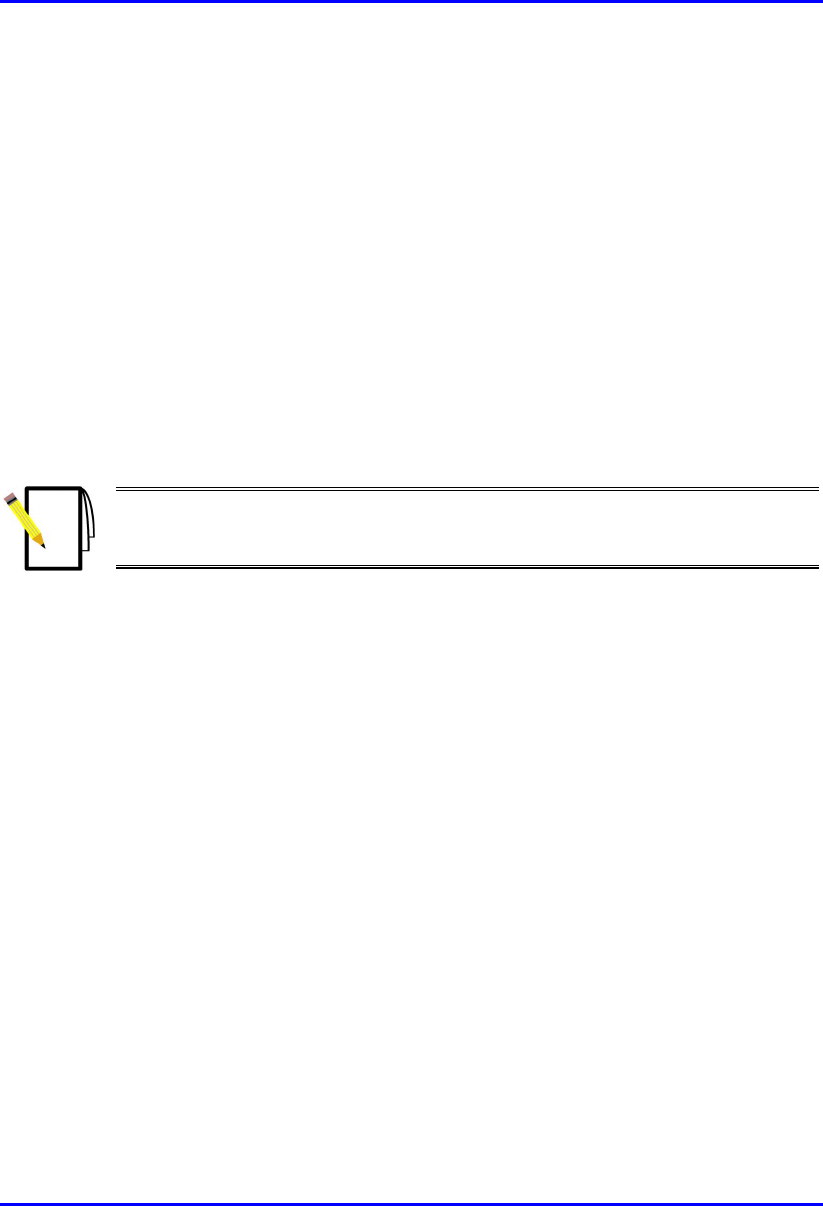
Overview Hardware Installation Guide
1-6 Airspan Networks Inc. 02030311-07
1.3.3. Base Station Distribution Unit (BSDU)
The BSDU is an Ethernet switch implemented at Base Stations consisting of
multiple BSRs. The BSDU provides 100Base-T interface between the BSRs and the
provider's backbone. The BSDU is also responsible for providing BSRs with –48
VDC power supply and frequency hop synchronization between BSDUs, BSRs, and
Base Stations (when a GPS is implemented).
The BSDU is installed indoors in a standard 19-inch cabinet, and connects to the
BSRs by standard CAT-5 cables. Each BSDU can connect to a maximum of six
BSRs. In addition, up to four BSDUs can be daisy-chained to support a maximum of
24 BSRs. Therefore, a Base Station at maximum configuration can serve up to 3,024
subscribers.
Note: At a Base Station consisting of a single BSR, the BSR typicall
y
interfaces with the provider's backhaul through the SDA instead of the BSDU.
(See Section 1.4.1, "Outdoor Radio (SPR) with Indoor Switch/Hub").
1.3.4. SDA-1/48V
The SDA-1/48V is a compact indoor adapter, especially designed for use when
available power source is 48VDC (i.e. no AC power supply), and when no
synchronization is required (i.e. in licensed bands). The SDA-1/48V provides the
BSR with Ethernet connectivity to the backhaul.
1.3.5. Global Positioning System (GPS) - Optional
The GPS antenna is a rugged, self-contained GPS receiver and antenna that receives
a universal GPS satellite clock signal. The GPS is an optional unit that connects to
the BSDU. The GPS synchronizes frequency hopping of multiple Base Stations,
ensuring that the entire ASWipLL network operates with the same clock based on a
universal satellite clock signal, and, thereby, eliminating radio frequency ghosting
effects.

Hardware Installation Guide Overview
02030311-07 Airspan Networks Inc. 1-7
1.3.6. Base Station Power Supply (BSPS) - Optional
The BSPS is an optional third-party unit that is implemented at Base Stations to
provide –48 VDC power supply and power redundancy. The BSPS is installed in a
standard 19-inch cabinet and connected to the BSDU.
The BSPS provides the BSDUs and BSRs with the following:
! Power supply of –48 VDC.
! Power redundancy in case of power failure. The BSPS charges a battery bank
that provides this power redundancy during mains failure. Thus, the BSPS acts
as a DC-uninterruptible power supply (UPS) with a battery connected to it. The
size of the battery determines the backup and charging time. Since the system is
current limited, the maximum battery size is based on that limit.
! Remote power management and monitoring (by ASWipLL’s WipManage
program).
The BSPS consists of the following basic components:
! Main unit:
! DC Rectifier modules: converts AC current to DC. The BSPS can house up
to four rectifiers. The rectifiers are “hot plugged” and operate in parallel.
This enables the user to define an N+1or N+2 redundant system. Each
rectifier has its own current sharing system, satisfying a complete sharing
among rectifiers.
! System controller: provides BSPS management control and BSPS operating
information.
! Electronic Low Voltage Detector (ELVD): disconnects the battery from
the load, avoiding damage to the battery when over-discharged.
! Load and battery circuit breakers: provide DC protection and distribution.
! DC Distribution unit: provides circuit breakers for distributing the output
current to multiple BSDUs. It also contains a bypass switch to bypass the LVD.
! Battery: provides the BSPS system with back-up power.
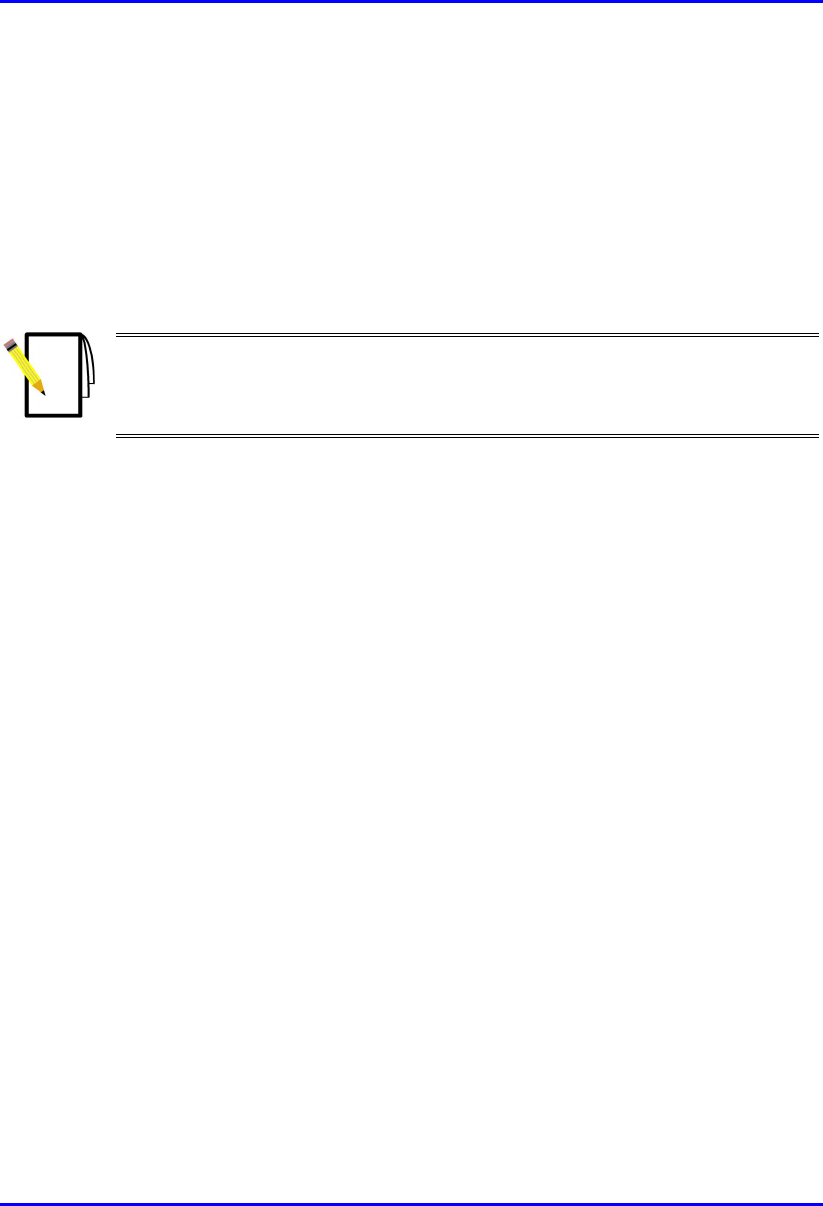
Overview Hardware Installation Guide
1-8 Airspan Networks Inc. 02030311-07
1.4. Subscriber Site Units
The ASWipLL subscriber units are located at the subscriber's premises. The
ASWipLL subscriber site consists of a radio transceiver that receives and transmits
signals from and to the Base Station. The radio transceiver provides the subscriber
with high-speed data access, Internet access, and VoIP at up to 4 Mbps. The
ASWipLL radios interface with the subscriber's Ethernet network either through a
hub or switch, or directly, depending on ASWipLL radio model.
Note: For VoIP support, Airspan can provide a third-party residential gatewa
y
(RGW). The RGW typically provides two POTS ports for telephony, a 10BaseT
LAN port for subscriber PC/network, and a 10BaseT port for connecting to the
SDA or IDR (depending on subscriber site configuration).
The ASWipLL system provides two different subscriber site configurations:
! Outdoor radio (i.e. SPR) with indoor Ethernet switch/hub (i.e. SDA)
! Indoor radio only (i.e. IDR device)
1.4.1. Outdoor Radio (SPR) with Indoor Switch/Hub
(SDA)
The outdoor radio with indoor Ethernet switch/hub configuration consists of the
ASWipLL Subscriber Premises Radio (SPR) and the ASWipLL Subscriber Data
Adapter (SDA), respectively.
1.4.1.1. Subscriber Premises Radio (SPR)
The SPR is an outdoor radio transceiver that provides a wireless link between the
subscriber’s network and the Base Station.
The SPR connects to the subscriber’s network through the SDA Ethernet hub/
switch. The SDA provides the SPR with DC power, lightening protection, and
Ethernet (10Base-T and/or 100Base-T) interface with the subscriber’s PCs/network
(up to four PCs depending on SDA model).

Hardware Installation Guide Overview
02030311-07 Airspan Networks Inc. 1-9
The SPR is mounted outside on an external wall or on a pole. The SPR connects to
the SDA by a standard CAT-5 cable.
The SPR is available in the following basic models:
SPR with Standard Gain Antenna: includes a built-in antenna with 15-dBi
antenna gain, covering an area of 23 degrees.
SPR with High-Gain Antenna: includes a built-in antenna with 18-dBi antenna
gain, covering 15 degrees.
SPR with External Antenna: includes an N-type connector port for attaching a
third-party external antenna.
1.4.1.2. Subscriber Data Adapter (SDA)
The SDA is a switch or hub (depending on model), providing the SPR with -48
VDC power supply, lightening protection, and 10/100BaseT interface to the
subscriber’s PCs/network.
The SDA is installed indoors and can be mounted on a wall or simply placed on a
desktop. The SDA connects to the SPR by a standard CAT-5 cable.
The SDA is available in the following models:
SDA-1: hub providing one 10BaseT interface with the subscriber’s computer (or
LAN network if connected to another hub or a switch).
SDA-1/DC: adapter that provides Ethernet (one 10BaseT) and regulated
–48 VDC power to the SPR. This model can be powered from a voltage of 10 –
52 VDC (e.g. from a solar panel that typically provides 12 VDC). This model is
typically implemented in mobile wireless applications, e.g. in a car or truck.
(This model can also be implemented at a Base Station with a BSR.)
SDA-4H: hub providing four 10BaseT interfaces with the subscriber’s
computers and/or networks. One of the 10BaseT ports provides crossover
cabling for interfacing with another hub or LAN switch. Alternatively, it may be
connected to another PC via a crossed Ethernet cable.

Overview Hardware Installation Guide
1-10 Airspan Networks Inc. 02030311-07
! SDA-4S: integrated LAN switch, providing four 10/100BaseT interfaces with
the subscriber’s PCs/network. The ports of the SDA-4S models support Auto
Negotiation, allowing automatic configuration for the highest possible speed
link: 10BaseT or 100BaseT, and Full Duplex or Half Duplex mode. In other
words, the speed of the connected device (e.g. a PC) determines the speed at
which packets are transmitted through the SDA-4S port. For example, if the
device to which the port is connected is running at 100 Mbps, the port
connection will transmit packets at 100 Mbps. If the device to which the port is
connected is running at 10 Mbps, the port connection will transmit packets at 10
Mbps.
The SDA-4S ports also support automatic MDI/MDI-X crossover detection,
allowing connection of straight-through or crossover CAT-5 cables to any port.
The SDA-4S is available in the following models:
! SDA-4S (standard): standard integrated LAN switch, providing four
10/100BaseT interfaces with the subscriber’s computers. This model is ideal
for SOHO implementation.
! SDA-4S/VL: provides VLANs between ports and the SPR, ensuring privacy
between LAN users of the different ports. For example, all users connected
to Port 1 do not “see” users connected to Port 2. This model is ideal for
multi-tenant (VLAN security) implementation.
! SDA-4S/VLtag: ideal for multi-tenant applications where traffic engineering
and privacy is required. SDA-4S/VLtag assigns a specific VLAN ID to
traffic, based on the SDA-4S/Vltag port at which the traffic arrives. The
VLAN IDs are fixed (since SDA-4S/VLtag is not user configurable). SPR
converts the four VLAN IDs tagged by SDA-4S/VLtag to four VLAN IDs
configured through ASWipLL’s network management system (WipManage).
The tag conversion is performed by SPR before sending the traffic to the air
(i.e. to the BSR) and vice versa when coming from the air.
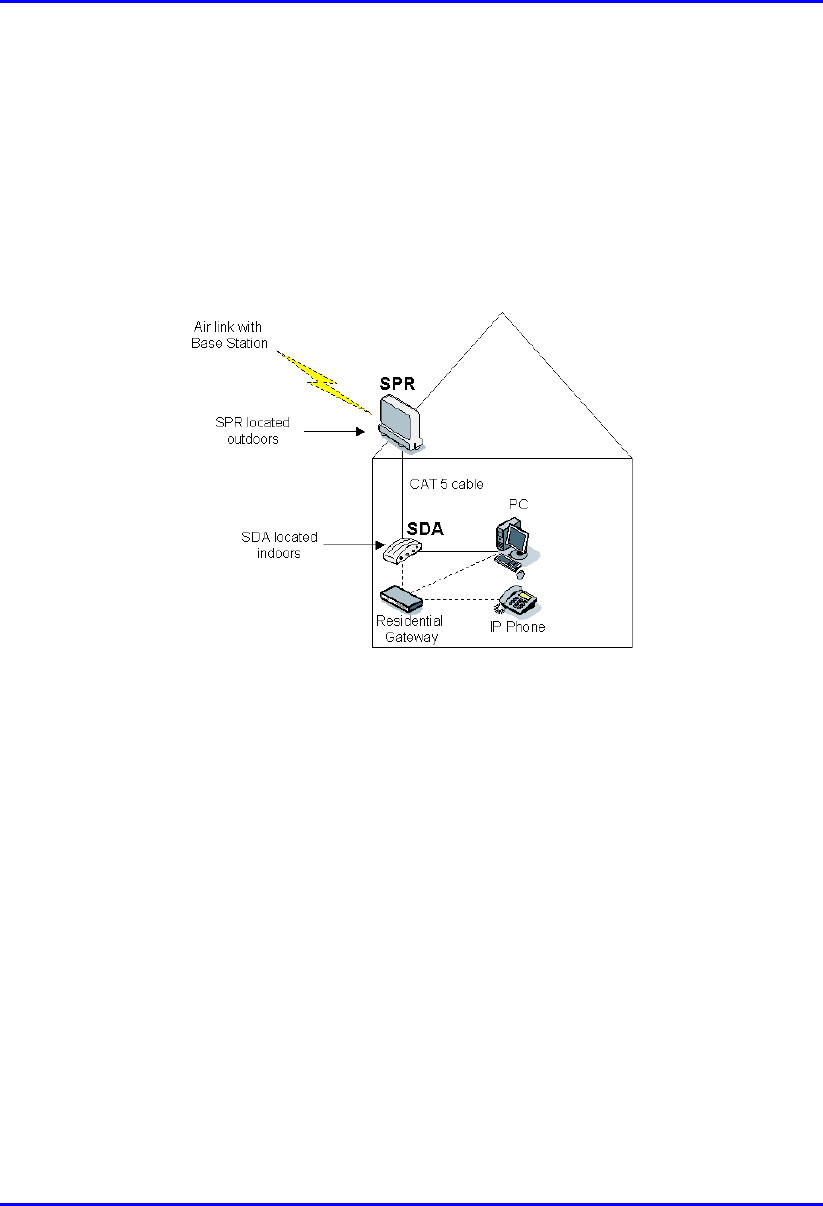
Hardware Installation Guide Overview
02030311-07 Airspan Networks Inc. 1-11
! SDA-4S/1H3L: provides a high priority port (left-most port) for VoIP
traffic.
! SDA-4S/VL/1H3L: combines the functionality of the SDA-4S/VL and
SDA-4S/1H3L models (i.e. VLAN for each port and a high priority port for
VoIP).
Figure 1-3 displays a typical subscriber site setup implementing an SPR and SDA.
Figure 1-3: Subscriber site with SPR and SDA units (optional RGW)
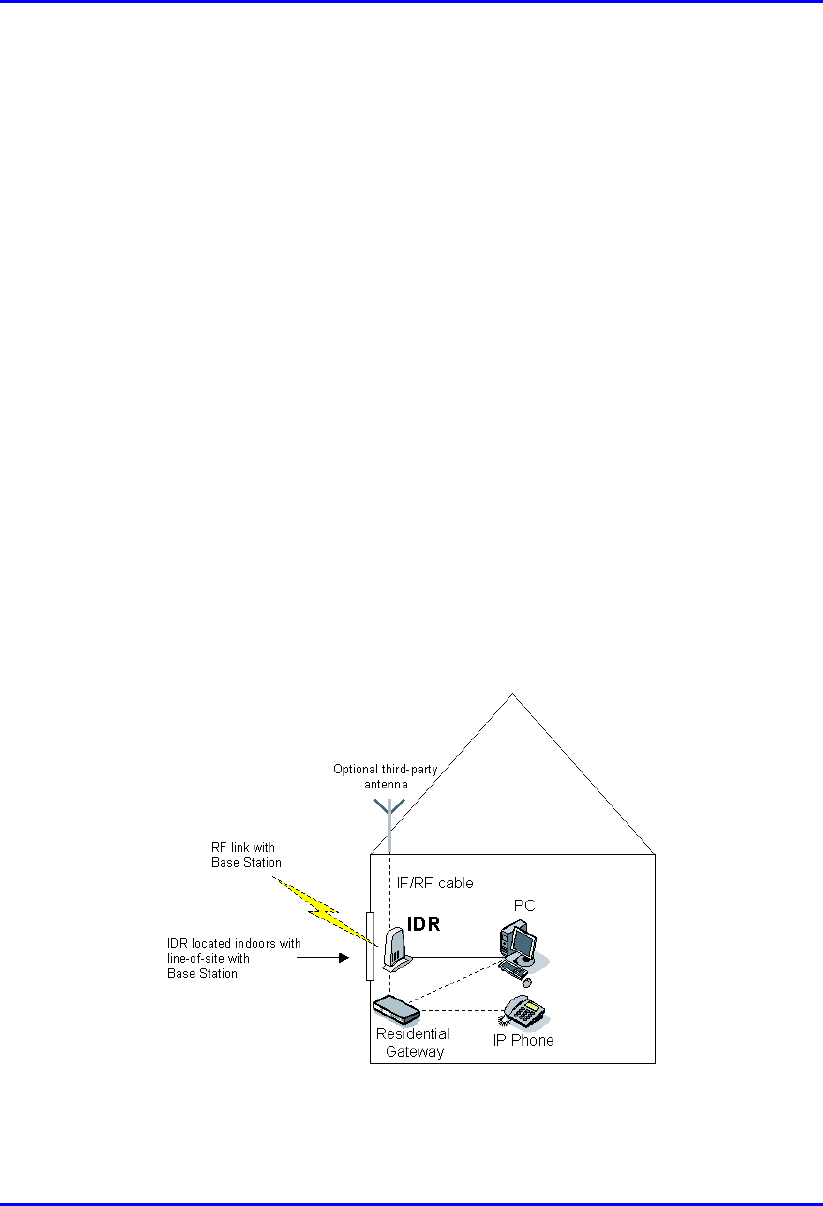
Overview Hardware Installation Guide
1-12 Airspan Networks Inc. 02030311-07
1.4.2. Indoor Radio Unit (IDR) Only
The indoor radio unit configuration consists of the ASWipLL Indoor Data Radio
(IDR). The IDR combines the functionality of the SPR and SDA, functioning as a
transceiver and a hub. The IDR provides one 10BaseT Ethernet interface to the
subscriber's network. The IDR receives its power from a separate power supply unit
(AC-DC power adapter).
The IDR is available in two models:
! IDR with a built-in internal antenna
! IDR with a TNC connector for attaching a third-party external antenna
The IDR with a built-in antenna is typically mounted on an interior wall or on a
desktop with line-of-site with the Base Station. The antenna of the IDR model with
an external antenna is typically mounted outdoors to provide line-of-site with the
Base Station.
The IDR can be used for data and voice transmissions. In the case of voice, the IDR
uses a third-party RGW to interface with the subscriber’s IP phone. Figure 1-4
displays a typical setup for data and voice at a subscriber site implementing the IDR.
Figure 1-4: Subscriber site with IDR and third-party external antenna (optional RGW)
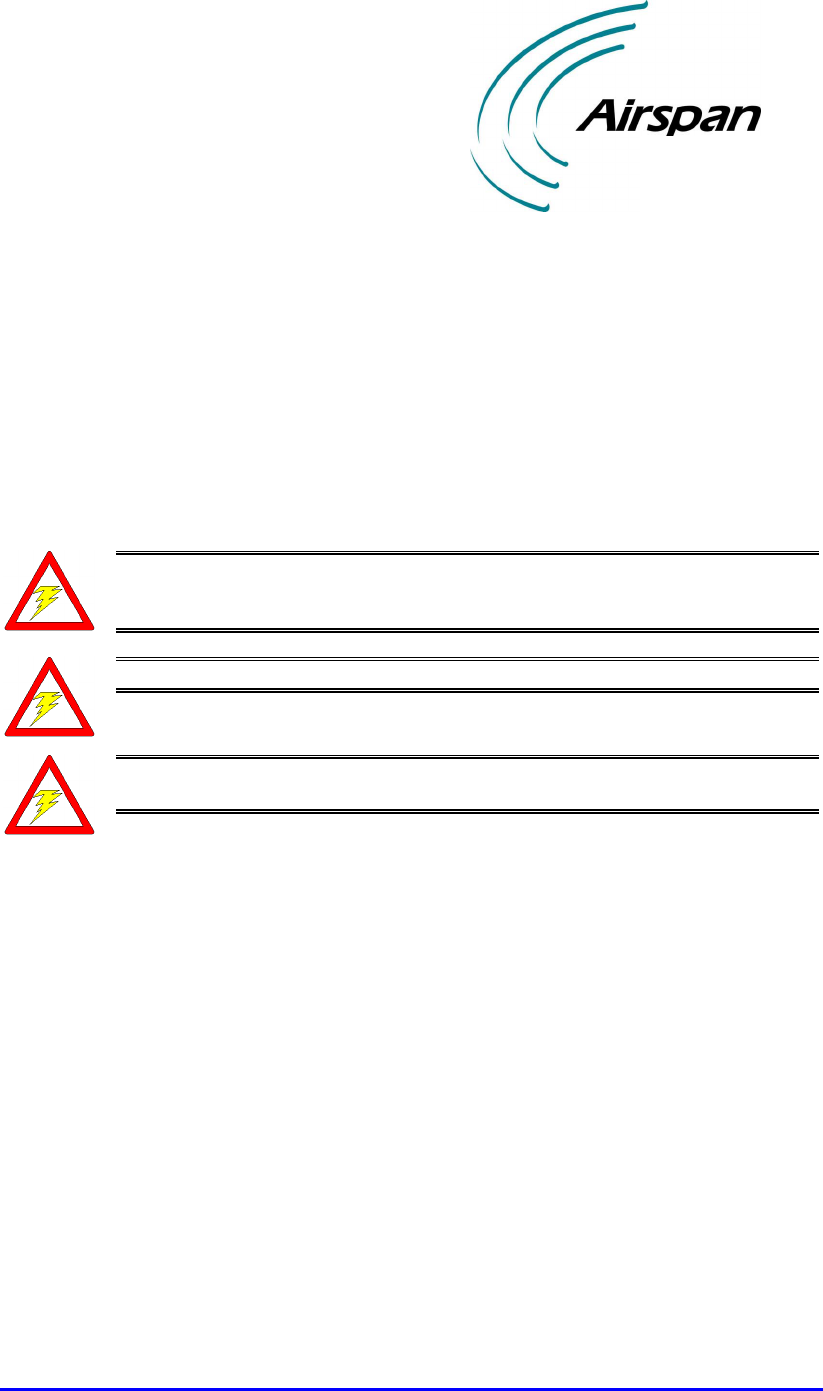
02030311-07 Airspan Networks Inc. 2-1
Safety Guidelines
Safety GuidelinesSafety Guidelines
Safety Guidelines
This chapter outlines safety guidelines when installing the ASWipLL system.
Warning: The user and the installer should be aware that changes and
modifications not expressly approved by Airspan Networks could void the
user’s authority to operate the equipment.
Warning: Never install equipment that is damaged.
Warning: Only qualified personnel should be allowed to install, replace, and
service the ASWipLL equipment.
2
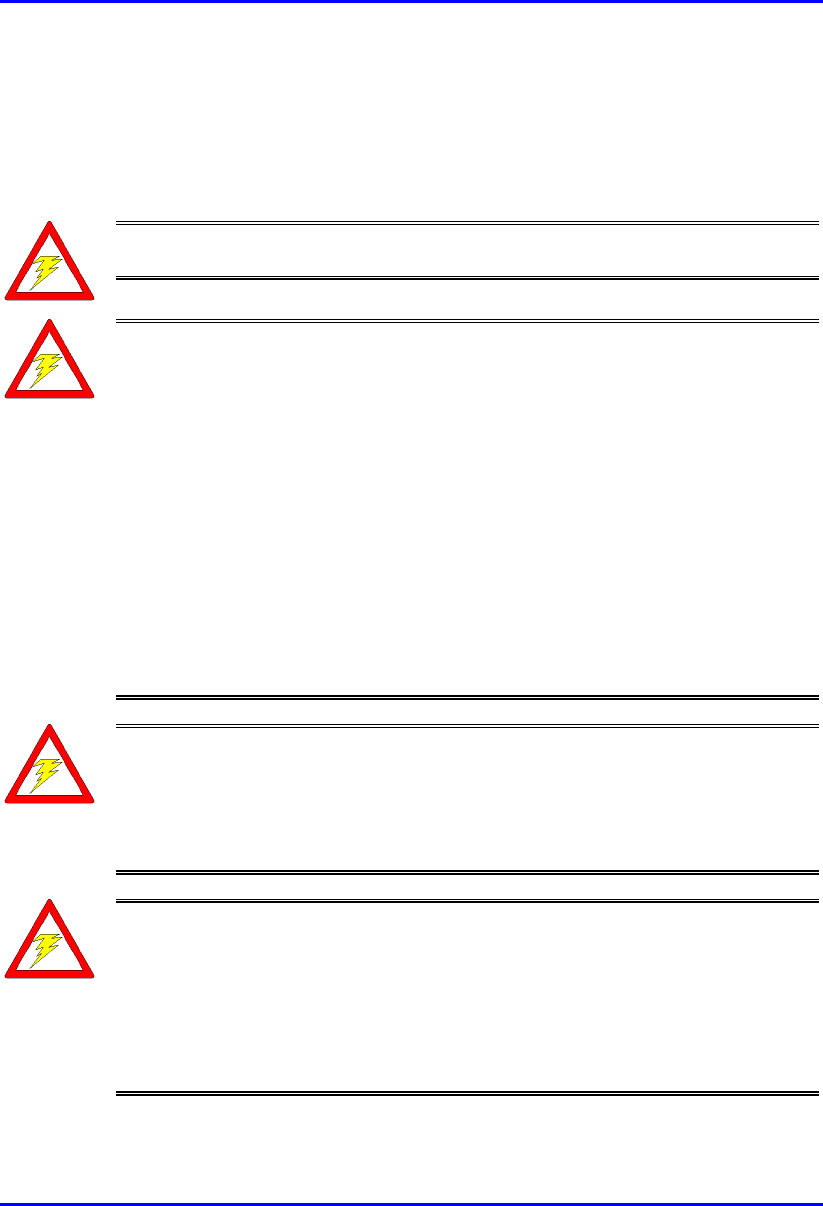
Safety Guidelines Hardware Installation Guide
2-2 Airspan Networks Inc. 02030311-07
2.1. ASWipLL Radios and Third-Party External
Antennas
Warning: Do not connect and disconnect antennas while the power is on. This
can cause irreversible device damage.
Warning: The digital portion of the transceiver has been tested and found to
comply with the limits for a Class B digital device, pursuant to part 15 of the
FCC rules. These limits are designed to provide reasonable protection against
harmful interference in a residential installation. This equipment generates,
uses, and can radiate radio frequency energy and, if not installed and used in
accordance with the instructions, may cause harmful interference to radio
communications. However, there is no guarantee that interference will not
occur in a particular installation. If this equipment does cause harmful
interference to radio or television reception, which can be determined by
turning the equipment on and off, the user is encouraged to try correct the
interference by performing one or more of the following measures:
- Reorientate or relocate the receiving antenna
- Increase separation between the equipment and receiver
- Connect the equipment to an outlet on a circuit different from that to which
the receiver is connected
- Consult the dealer or an experienced radio/TV technician for help
Warnings:
1) The device cannot be sold retail, to the general public or by mail order. It
must be sold to dealers.
2) Installation must be controlled.
3) Installation must be performed by licensed professionals.
4) Installation requires special training.
Warning: The ASWipLL radio devices and antennas should be installed
ONLY by experienced installation professionals who are familiar with local
building and safety codes and, wherever applicable, are licensed by the
appropriate government regulatory authorities. Failure to do so may void
A
irspan’s ASWipLL product warranty and may expose the end user or the
service provider to legal and financial liabilities. Airspan and its resellers o
r
distributors are not liable for injury, damage or violation of regulations
associated with the installation of outdoor units or antennas.
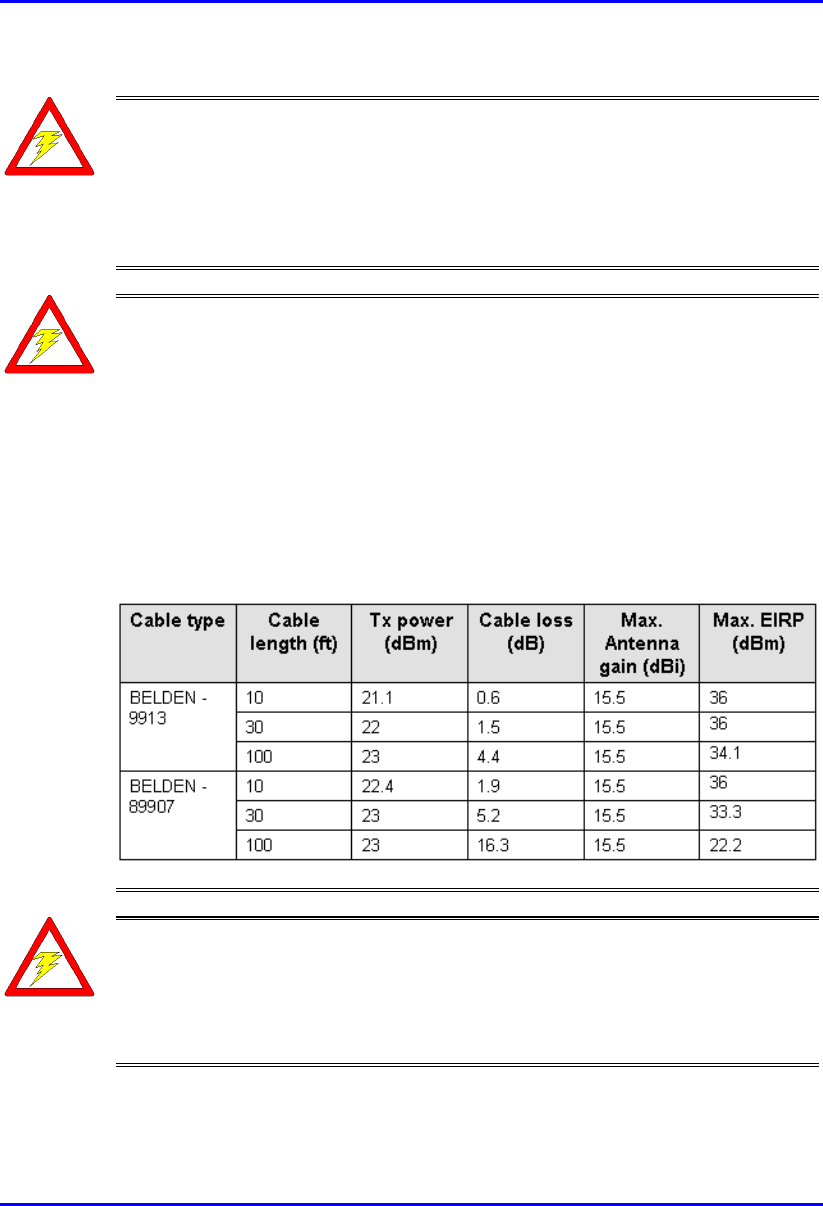
Hardware Installation Guide Safety Guidelines
02030311-07 Airspan Networks Inc. 2-3
Warning: For unlicensed bands, it is the responsibility of the person installing
the ASWipLL system to ensure that when using the outdoor antenna kits in the
United States (or where FCC rules apply), that only those antennas certified
with the product are used. The use of any antenna other than those certified
with the product is expressly forbidden in accordance with FCC rules CFR47
part 15.204. The installer should configure the output power level of antennas
according to country regulations and per antenna type.
Warning: For unlicensed bands, in accordance with FCC regulations, ensure
that the external antennas provide an EIRP of less than or equal to 36 dBm to
prevent interference with other radios operating in the unlicensed band. The
EIRP is defined by the following formula:
Max. Power Output + Antenna Gain - Cable Loss ≤
≤≤
≤ 36 dBm (EIRP)
Airspan does not supply cables for connecting external antennas. It is the
responsibility of the installer to provide the cable and ensure the cable
characteristics (e.g. length and cable loss) enables adherence to FCC's
regulations concerning maximum EIRP.
The table below lists examples of cable loss per cable (not supplied by
Airspan) for maximum antenna gains, based on the formula above. Note that
the EIRP is either equal to or less than 36 dBm.
Warning: The ASWipLL transceivers emit microwave radiation. Therefore, a
minimum distance must be maintained from the front of the ASWipLL radios:
- Unlicensed bands (e.g. 5.8 GHz): 200 mm
- Licensed bands:
- 700 MHz (i.e. ASWipLL 700) = 800 mm
- 2.5 GHz (i.e. ASWipLL 2.5) = 500 mm
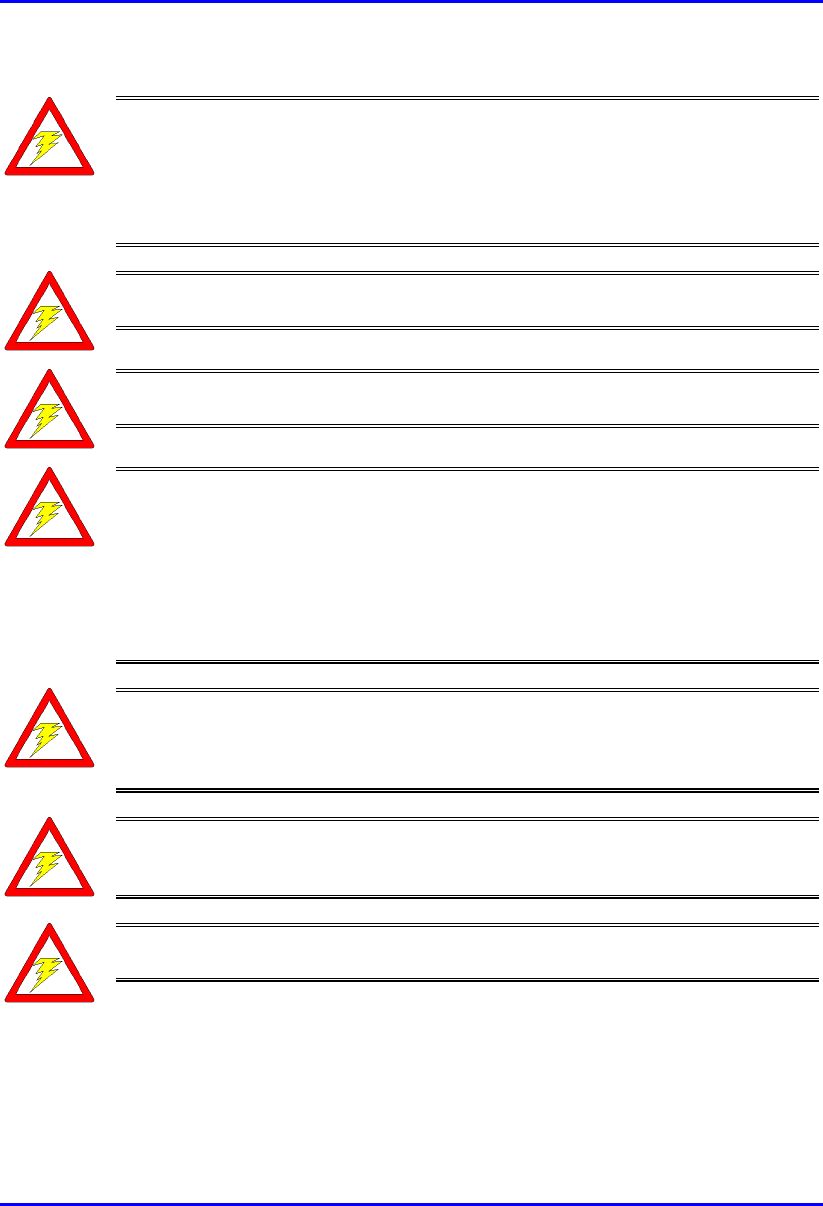
Safety Guidelines Hardware Installation Guide
2-4 Airspan Networks Inc. 02030311-07
Warning: To avoid RF interference between BSRs operating in the 700 MHz
where four BSRs are installed at a Base Station, a 1-meter separation must be
provided between the BSRs' antennas operating in the lower frequencies (i.e.
711.5 and 714.5 for 1 Msps mode; 712 and 714 for 1.33 Msps mode) and the
BSRs' antennas operating in the upper frequencies (i.e. 741.5 and 744.5 for 1
Msps mode; 742 and 744 for 1.33 Msps mode).
Warning: When using external antennas, the external antennas must not be
co-located or operating in conjunction with any other antenna or transmitter.
Warning: ASWipLL radios using an external antenna(s) must not be co-
located or operating in conjunction with any other antenna or transmitter.
Warning: Inherent risks exist in operating equipment in license-exempt bands
(i.e. 900 MHz). Airspan recommends that you do not purchase or deploy any
equipment that operates in license-exempt bands without first analyzing the
interference environment at each of your proposed deployment locations.
Please contact your Authorized Airspan System Integrator or Distributor if you
have any questions or require assistance regarding interference analysis.
Airspan Networks will not be held responsible for product performance issues
related to interference.
Warning: In environments that produce disturbances such as paging systems,
Airspan recommends using a narrow-band cavity filter and implementing the
appropriate frequency bands (within the filter's capabilities), i.e. building an
NVRAM frequency table using only these frequencies.
Warning: Mount outdoor radios so that their front panel ports face down to
prevent water from settling on the ports. This avoids damage to the units such
as corrosion and electrical short-circuiting.
Warning: Do not mount outdoor radios and external antennas in weathe
r
such as rain or lightening that may increase risk of electrocution.
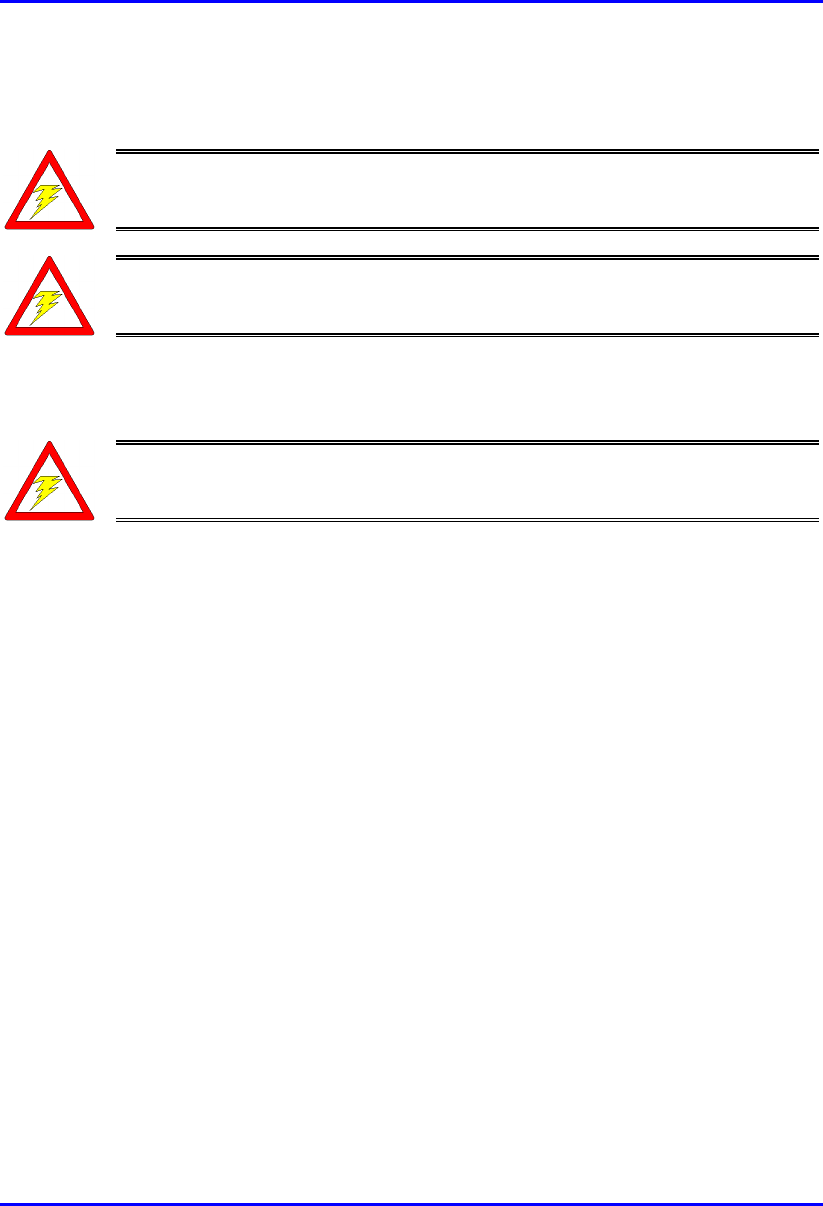
Hardware Installation Guide Safety Guidelines
02030311-07 Airspan Networks Inc. 2-5
2.2. Electrical Safety Guidelines
Warning: Connect the power only after all network and antenna cable
connections are performed. Powering the device before connecting, fo
r
example, the external antenna, can lead to irreversible device damage.
Warning: To prevent short-circuiting and electrical shocks, cables with
exposed ends (i.e. not yet crimped) should be covered with protective
polythene bags during external cable installation processes.
2.2.1. Handling Electrostatic Devices
Warning: To prevent ESD damage to ASWipLL devices, always wear an ESD
wrist strap when handling these devices or coming into contact with internal
components.
Electrostatic devices are those devices that may be damaged by the inadvertent
discharge of static electricity from a charged body. The risk of damage, due to
electrostatic discharge (ESD) to a device, may cause the device to fail suddenly, or it
may induce a partial defect within the device, which will cause subsequent
premature failure. Static electricity can result from operators walking on floors,
moving around on chairs, from the movement of operator's clothing or even casual
brushing against racks, benches or walls.
Airspan recommends the following guidelines to be adopted to minimize the risk of
component failure due to electrostatic discharge to the device:
! ASWipLL devices are provided typically in see-through anti-static bags.
Wherever possible, checking and inspection of a unit should occur without
removing it from the bag.
! All operators shall wear the approved conductive overall.
! Where operators come into direct contact with any piece of electronic hardware,
operators must wear an ESD-preventive wrist strap. All straps and cords
should be tested using a Wrist Strap Tester prior to use. The wrist strap cords
shall have a 2 Meg Ohm resistor fitted at either end. Wrist straps should be worn
in direct contact with bare skin and not over clothing.
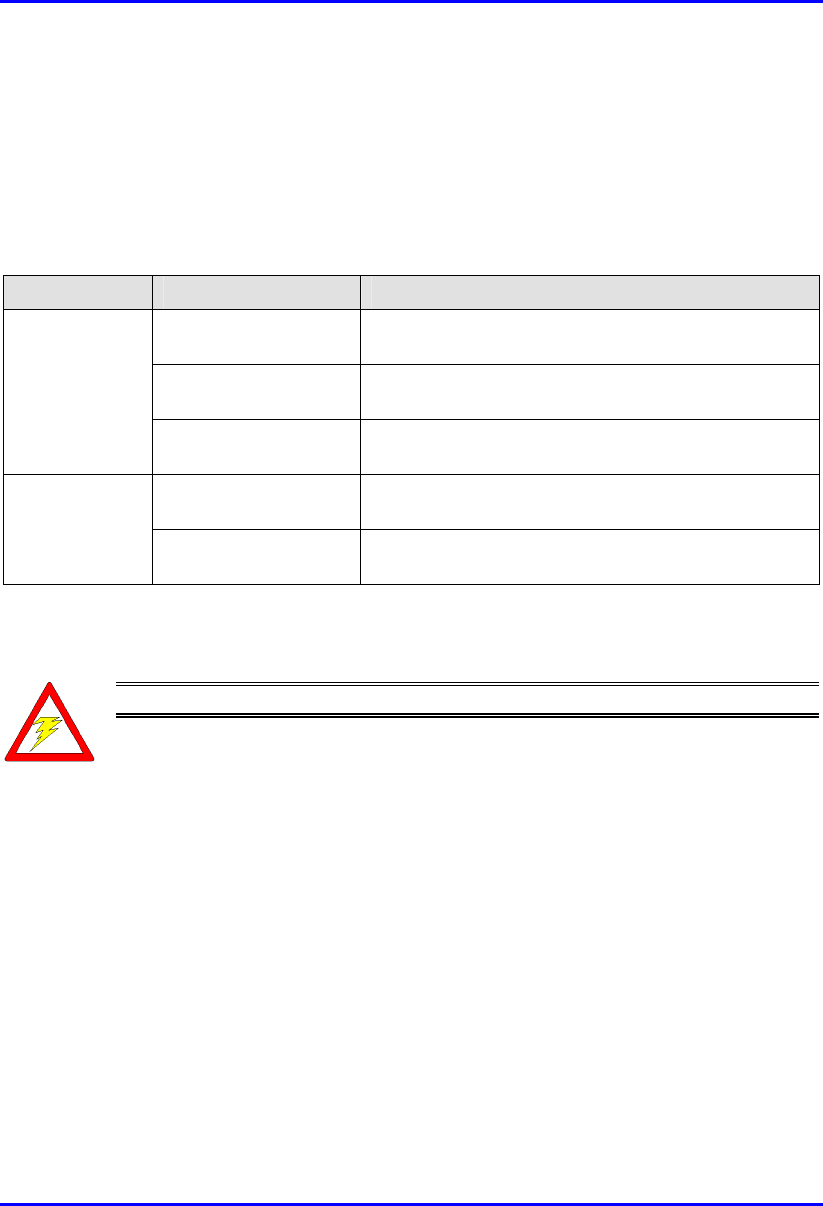
Safety Guidelines Hardware Installation Guide
2-6 Airspan Networks Inc. 02030311-07
2.2.2. Grounding
Only certain ASWipLL devices require additional grounding. ASWipLL devices
that do not require additional grounding have grounding at the main supply outlet.
The following table lists the ASWipLL devices’ grounding requirements.
Table 2-1: ASWipLL grounding requirements
Site ASWipLL device Grounding
BSR Through the mains (via BSDU) i.e. no additional
grounding required
BSDU Additional grounding required (grounding lug at rear
end of chassis)
Base Station
BSPS Additional grounding required (grounding lug at rear
end of chassis)
SPR Through the mains (via SDA), i.e. no additional
grounding required
CPE
IDR Through the mains, i.e. no additional grounding
required
2.2.3. Lightening Protection
Warning: Never install the equipment during stormy weather and lightening.
ASWipLL devices comply with the Surge Immunity standard: EN 61000-4-5.
ASWipLL devices are protected from lightening surges as the outdoor devices
(BSRs and SPRs) are encased in a plastic chassis. Therefore, if lightening strikes the
device, an electrical circuit cannot be completed, and hence, no electrical surge can
occur.
In addition, ASWipLL outdoor and indoor (SDA) devices provide high-speed data
line protection against direct and induced transient over-voltages surges on the
cables. This capability is provided by the fact that all ASWipLL devices are
designed with TVS (transient voltage suppressor) components that maintain
potential differences.
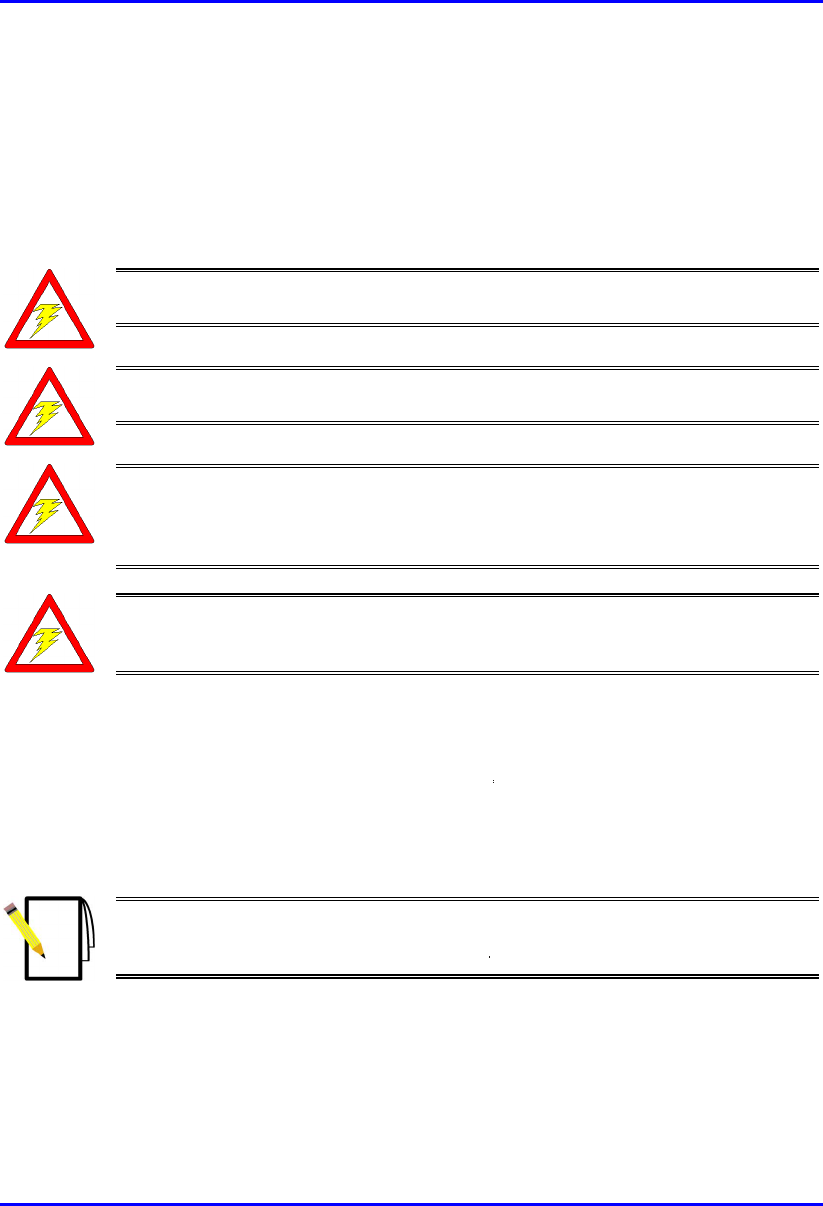
Hardware Installation Guide Safety Guidelines
02030311-07 Airspan Networks Inc. 2-7
However, for geographical areas that have above normal lightening activity, Airspan
can supply a surge protector composed of a 15-pin D-type adapter with a grounding
wire.
2.3. Cabling
Warning: The maximum cable length between the radio transmitters (i.e. BSR
and SPR) and terminating equipment is 100 meters.
Warning: Cables with exposed ends (i.e. not yet crimped) should be covered
with protective polythene bags during external cable installation processes.
Warning: Prior to the commencement of any installation, commissioning work
at ‘live’ sites it is the responsibility of the Airspan engineer to advise the
customers representative before any activity commences. If in doubt assume
equipment is ‘live’.
Warning: Disturbance of cables on an In-Service exchange can cause loss o
f
service. Extreme care must be taken when installing cables at any customer o
r
subscriber premises.
2.3.1. Considerations
The following issues should be considered during cabling at the ASWipLL Base
Station and customer premises:
! Cable routes are to be defined in the site-specific documentation.
Note: A minimum separation of 200 mm should exist between power and data
cables. However, it is permissible to allow these cables to cross each other at
right angles.
! Observe recommended minimum bend radii when installing copper cables.
Wherever a cable changes direction, ensure that it does so in a smooth curve
with a radius of at least 50 mm to prevent damage.

Safety Guidelines Hardware Installation Guide
2-8 Airspan Networks Inc. 02030311-07
! Plastic ties and wraps are to be used to secure cables at regular intervals to trays,
guides, and mounting pole/bracket. Ensure all trimmed ends are disposed of
safely and at regular intervals.
! Data cables of less than 20 pairs shall be mixed in bundles not exceeding 50 mm
in diameter.
! Ensure cables are not trapped in cabinet doors, by slide-in equipment or support
metalwork.
! Excessive stress on cable terminations caused by taught cables should be
avoided. Connector strain relief, if not built into the connector used, shall be
provided by means of a strategically located cable tie. A maintenance loop or a
generous amount of cable slack shall be provided just before the cable reaches
the ASWipLL device to allow for equipment removal without disturbance to
adjacent cables.
! When installing network cables, ensure they are not damaged by friction or sharp
edges.
! Data cables providing connection to the customers network shall be run in
protective conduits. Cable conduits should be secured to the wall in accordance
with manufacturers instructions.
! External data cables are to be protected in metal conduits, which are to be
secured to the building structure in accordance with manufacturers
recommendations.
! Wiring conduits must be placed in areas to prevent a trip hazard (e.g. don’t
install on roof walkways)
! Cables should be carefully fed through conduits and not pulled by means of any
attached connector.
! Sufficient space should be provided in cable conduits, trunking or trays (where
possible) to allow for future cabling growth.
! Data cables threaded into holes drilled in walls are to be covered by a waterproof
sheath to prevent water penetration.
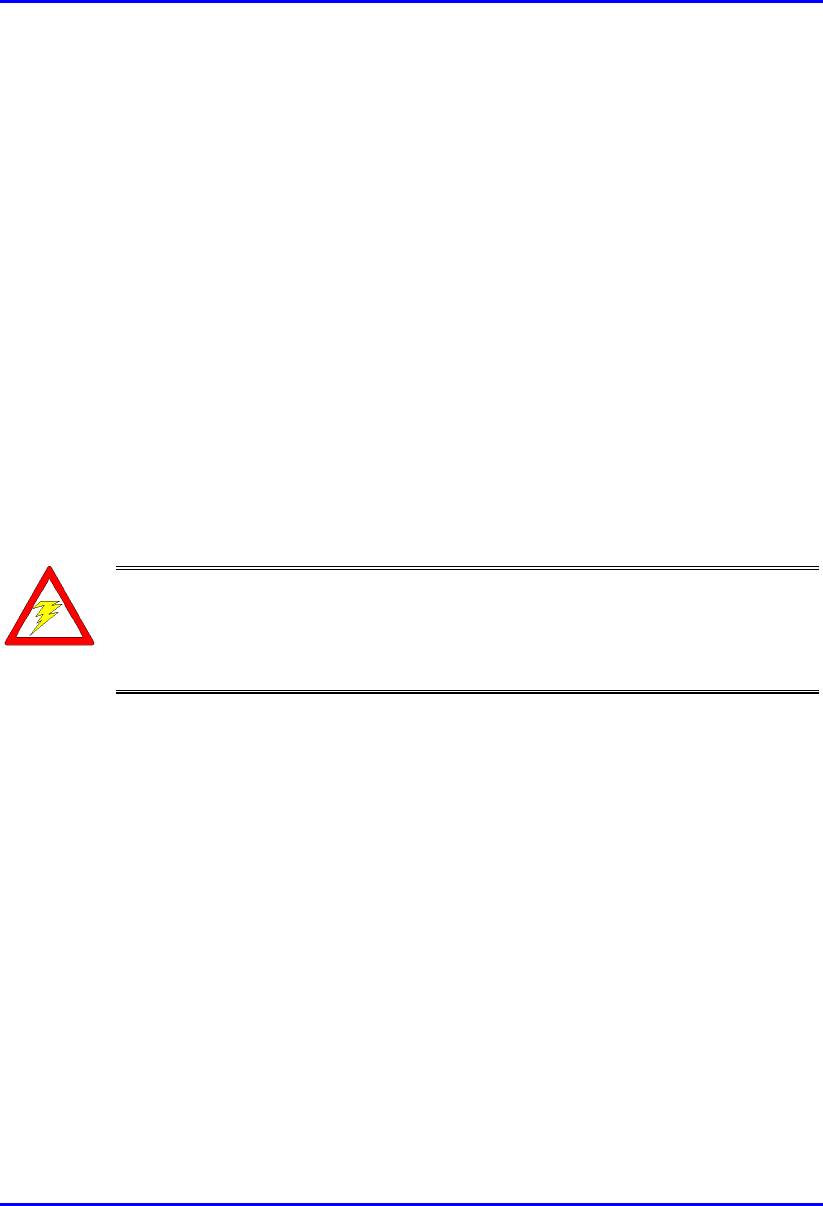
Hardware Installation Guide Safety Guidelines
02030311-07 Airspan Networks Inc. 2-9
! Silicone sealant should be used to plug any holes on both internal and external
wall surfaces once cables are in place.
! Cables not housed in conduits must be placed in a manner to avoid a trip hazard.
(Avoid trailing wires across passageways.)
2.3.2. Labeling
The following labels are required to be fitted to ASWipLL equipment:
! Voltage Warning
! High Earth Leakage Current
! Signal Cable Designation
2.3.2.1. Voltage Warning
Warning: Voltages over 30 Volts AC and 50 Volts DC are categorized as
hazardous. Hazard warning labels should be fitted where required. Certain
countries require equipment warning and instruction labels to appear in the
local language. When installing ASWipLL equipment ensure that local
requirements regarding labels are given consideration.
! Where mains power is fed from separate phases, appropriate warning labels must
be fitted to warn of the increased danger.
! The AC equipment used in the BSPS cabinet must carry a relevant voltage
warning label specific to the country in which it is being installed. The label will
be fitted to the cabinet doors displaying an electrical hazard symbol, the local
operating voltage and the letters ‘AC’.
! A power feed identification label (e.g. PWR ‘A’) shall be applied in the
following locations:
! On the rear of the main power rack adjacent to the terminal block
! Attached to BSPS AC mains power plug or lead
! Attached to the customer mains power socket or distribution rail
! On the BSPS power circuit connection at the fuse board

Safety Guidelines Hardware Installation Guide
2-10 Airspan Networks Inc. 02030311-07
2.3.2.2. High Earth Leakage Current
If equipment earth leakage current exceeds 3.5 mA, a warning label as shown in
Figure 2-1 must be fitted to the rear of the main power rack alongside the AC inlet
terminal block.
Figure 2-1: Warning label if earth leakage current exceeds 3.5 mA
2.3.2.3. Signal Cable Designation
All data cables should be labeled with both the source and destination at each end. A
wrap around identification label, similar to that shown in Figure 2-2, is to be fitted to
both ends of ASWipLL data cables. Care should be taken to ensure that the cable
identification information is clearly visible. Fit the label 100 mm from the cable end.
Wrap the label ensuring good adhesion to cable and itself.
From
BDSU 1/1
To
SPR 1
To
SPR 1
From
BDSU 1/1
BSDU End SPR End
Figure 2-2: Typical signal cable identification label
WARNING
HIGH LEAKAGE CURRENT
Earth connection essential
Before connecting supply